- Find a Guide
- Walks & Tours
- Members Area

Discover Official Walks & Talks
Roman london tour: thurs & sun.
The original City beneath our feet
What have the Romans ever done for us Londoners? Plenty!
Join our Roman guided tour and let us ‘roam’ around the City and discover a history that dates back nearly 2,000 years. Let one of our qualified City of London Guides reveal the ancient city of Londinium that lies beneath your feet.
- Learn why the Romans founded the City of Londinium, what they bought - and what they liked to export.
- See the site of a Roman bathhouse that’s now a pretty garden
- Discover a temple to Mithras that was only discovered after bombing in World War Two
- Take in a view of the original Roman wall that guarded the City 1,800 years ago.
Please note: children must be accompanied by an adult at all times.
BOOK YOUR PLACE HERE
Photos: courtesy of Niki Gorick
Read about our walk in the Londonist
We offer daily, weekly and monthly walks around the City of London
Our daily walks run from the City Information Centre, just south of St Paul's. You need to book via Eventbrite to secure you place. Note : the cut-off time for booking our daily walks is 21:00hrs the night before. If we don't have any bookings then the walk will not take place. Read our policy on Refunds .
Our weekly walks have individual booking pages and earlier cut-off times, please see the individual listing.
Pepys Day on September 6th NOW SOLD OUT
For one day only, this very special tour ends inside Mansion House to raise a glass with the Lord Mayor to toast Samuel Pepys and his Diary. Find out more
We've adde d 3 new walks for this season:
Secrets and Symbols, News from Fleet Street, and From Shakespeare to Oscar Wilde
Billingsgate Roman House and Baths open
This unique site is now open for this season of tours. Find out more.
Private tours
If you'd like to organise your own walk , lecture or a virtual tour, then please use our Find a Guide section. If you're a member of an Arts Society or a U3A, a school or another group we'd love to take you on a tour of the City. Or if you're a company based in the City who'd like to organise a social event for your work colleagues, then contact one of our qualified guides , who can put together an evening walk for you.
If you've been on a walk recently we'd love to hear from you. Why not leave a review on our TripAdvisor page? We've been awarded TripAdvisor's Travellers' Choice for 2023 and 2024!
Normal price, concessions.
City Information Centre
All Walks & Tours

London's River Walk: Saturdays
Find out dates & details

Dr. Samuel Johnson Guided Walks: Twice Monthly

Smithfield Market Tours

London Guided Walks » Roman London Walk
Roman London Walk
Step into Londinium see hugely impressive remains and hear stories of the first Londoners.
- Discover Roman London in the City of London
- Learn how Londinium was created and deserted
- Qualified City of London guide

Book with confidence:
- Book online 24/7
- Secure Payments
- Immediate Booking Confirmation
Explore London’s origins on this ninety-minute walk through the heart of the Roman city. We will look at both hugely impressive remains, and intriguing smaller parts of Londinium that most people just don’t know about.
We will look at why the city grew where it did, meet some of its inhabitants, and find out how it later became almost empty.
The sheer size of Roman London was truly impressive. Come along and discover the monumental history hidden beneath our feet.
- Start: Tower Hill
- End: Guildhall
- Suitable for 14yrs+

Your Guide: Jenny Funnell
Roman London Walk Reviews
Qualified London Tour Guides

All Upcoming Guided Walks
This website uses cookies to improve your browsing experience and analyze the use of the website. Learn More
Reserve Your Spot with Confidence! Full Refunds with 48 Hrs Notice. Reschedule at any point, even after tour, if space allows!

Roman London Tour

Tour Information
Roman london tour highlights.
In 43 A.D., Emperor Claudius successfully invaded Britain. After sailing up the Thames, the Romans had set up the port of the city of Londinium by 47A.D. But why did they choose here?
In 60 A.D. these new Roman visitors were welcomed by Queen Boudica who set fire to the new city, which prompted the Romans to build new fortified walls. That begins the crazy history of Roman London...

See the remains of Londinium defensive walls. Visit the original Roman London Bridge and walk the first major Street in London to the Forum! Gaze upon the long forgotten Wallbrook River and worship the cult of Mithras at its Roman Temple before having a civilising clean at the bath house. Enjoy fun and games at the Amphitheatre and learn how the Roman Legion influenced the economy at the Roman Fort: the Barbican.
But all good things must come to an end, even Londinium. Come with us to find out how and why! In this tour you will see:
- Roman Walls in hidden places
- The Tower of London
- All Hallows by the Tower site of a Roman House
- The site of a Bathouse near St Dunstan in the East
- Roman London Bridge at Church of St Magnus-the-Martyr
- The Forum and Basilica at Leaden Hall MarketT
- he London Mithraeum Roman Temple
- The Roman amphitheatre at the Guildhall
- The Barbican Roman fort

Searching Availability...
WHERE: Tour begins from in front of St. Botolph Without Aldgate Church ( map ) The church is adjacent to Aldgate Underground Station.
The tour ends near St. Paul's Cathedral.

Duration: Approximately 2.5 hours.
When: Wednesdays and Sundays at 14:00.
Cost: This tour is free to take, and you get to decide what, if anything, the tour was worth when it's done. A name-your-own-price tour is a tour for anyone's budget.
Save even more money with a London tourist discount card .
Be sure to check out our other tours in London .

And much, much more
North america, united kingdom & ireland, middle east & india, asia & oceania.
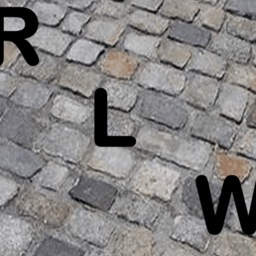
Real London Walks
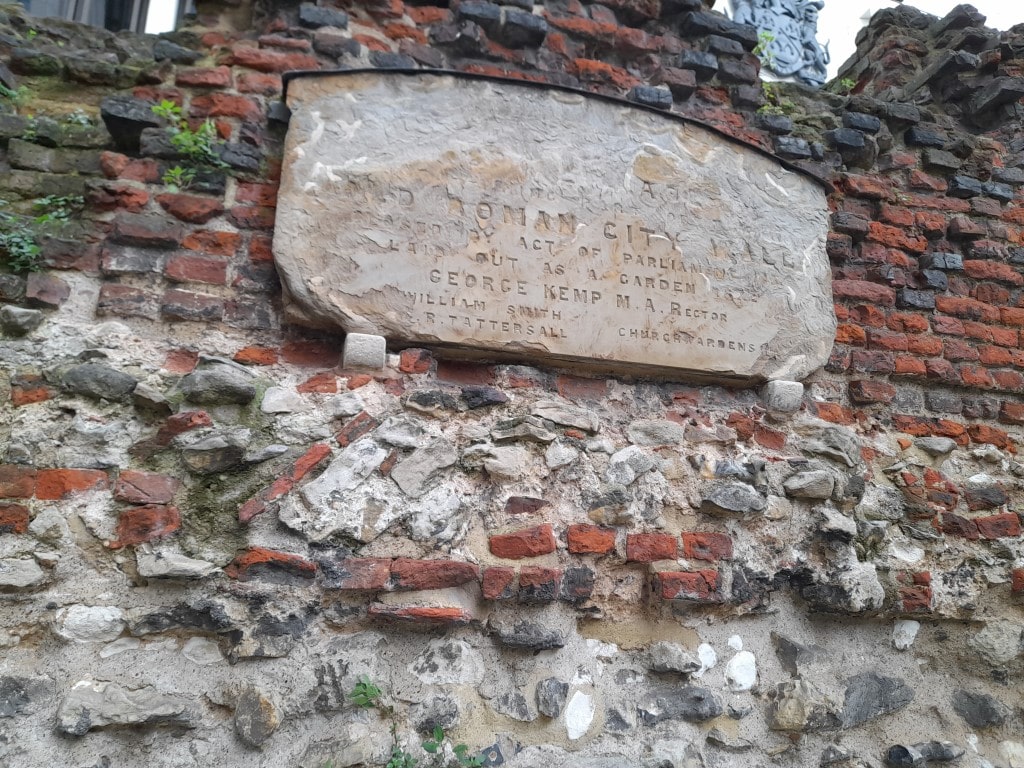
A Roman London Walking Tour
A day-tripper guide to Roman London.
Table of Contents
About the roman london walking tour.
According to mythology the earth was surrounded by a mighty sea called Oceanus; by extending the influence of Rome to the equivalent of outer space the Emperor Claudius was going against accepted wisdom.
Britain was worthless and scary at the same time – an island of dangerous people far from the civilised centre of the world.
Today if you know where to look, you too can experience the story of old Londinium and discover the threads that bind the ancient and modern worlds.
Key facts about this tour
What to expect on this walking tour.
This walking tour is 120 minutes long. You will walk approximately 1.5 miles and see hundreds of years of history.
Once you have experienced your tour you will be able to say you have seen:
- Booked entry to the Roman Mithraeum
- Roman wall remains
- Entry to the Roman Amphitheatre.
- And so much more!
Tour location map
Things to do after your tour
Once you’ve finished your walking tour why not visit some of the other exciting London locations below?
The Cafe Below
The Café Below, nestled in the crypt of St Mary-le-Bow Church in the heart of London, serves up locally sourced, hearty British cuisine in a unique, historic setting. As you enjoy your meal amidst centuries-old architecture, it’s an ideal spot for those looking for an authentic dining experience that seamlessly blends tradition with modern culinary art.
The Sky Garden, London’s highest public garden, offers stunning 360-degree views of the city from atop the Walkie Talkie building. With its lush, beautifully landscaped gardens, chic bars, and restaurants, it’s a sublime retreat that combines relaxation and sophistication, making it an essential visit for stunning cityscape views.
Book your ticket now
Related walking tours.
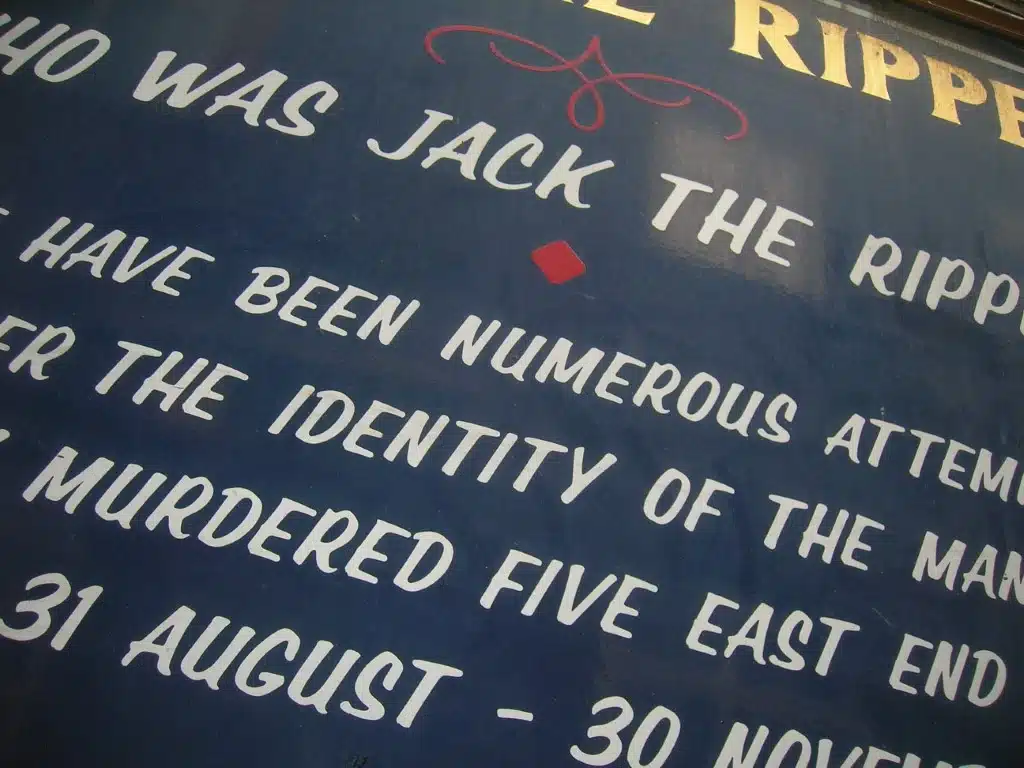
Jack the Ripper Tour
December 4, 2023
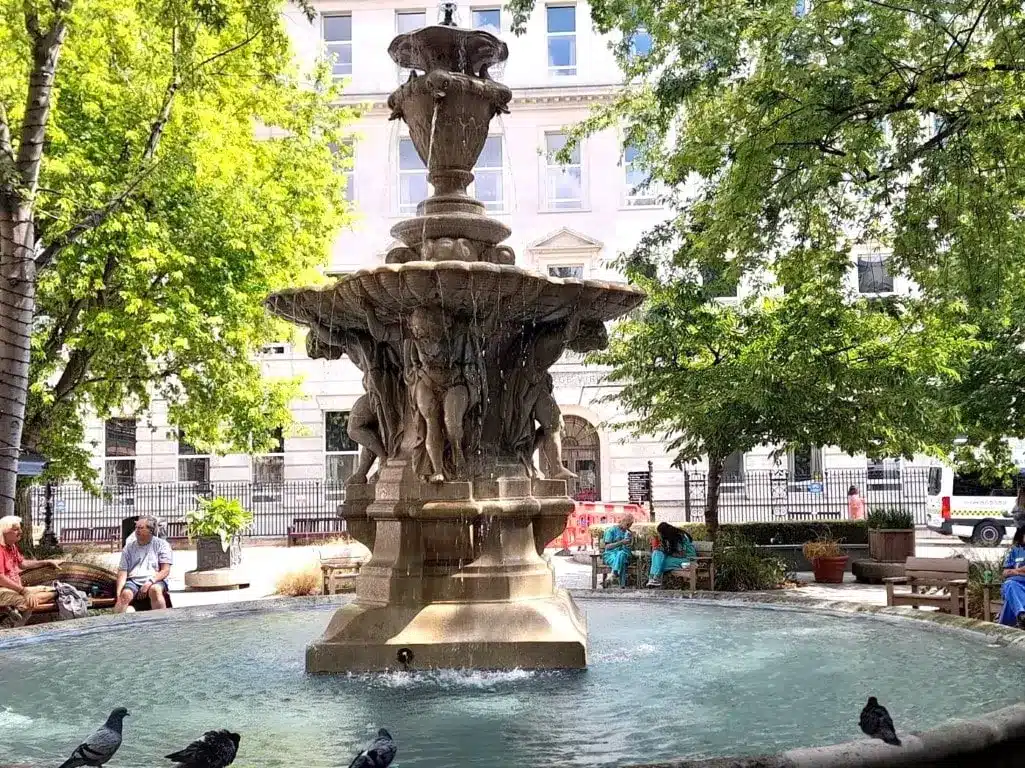
West Smithfield Monks to the Knights Hospitallers
November 20, 2023

Roman London
Who knew ..., date and time.
We use cookies to make your website experience better. Please confirm you accept the use of these cookies. To find out more about the cookies we use, please read our cookies policy
London’s Roman Amphitheatre
- Attractions
Opening times Mon to Sun 10am - 5pm (Last entry 4:45pm)
guildhall-art-gallery.myshopify.com
Guildhall Yard, EC2V 5AE
The London's Roman Amphitheatre is an interactive and educational attraction, which allows you to dive into the ancient history of Roman London.
Please note that on Monday 16 September Guildhall Art Gallery and London’s Roman Amphitheatre will be open from 2.30 to 5pm due to a private event.
Lost for centuries, the original circular walls of the Amphitheatre were rediscovered by archaeologists working on the site of the new Guildhall Art Gallery building in 1988. Visitors can now step into these well-preserved Roman ruins in which crowds would once have gathered to watch wild animal fights, public executions and gladiatorial combats.
Entry is free and included in Guildhall Art Gallery's admission ticket . Please note that, on Friday 19 July from 11am to 2:30pm, London’s Roman Amphitheatre will be closed to the public for a school reception. The remainder of the Gallery will open as normal. We apologise for any inconvenience this may cause.
For visitor information and accessibility visit the Guildhall Art Gallery page.
The discovery
In 1988, Museum of London archaeologists made an astonishing discovery that changed the face of Roman London. During an archaeological dig taking place in preparation for the new Art Gallery building project, it was found that the capital's only Roman amphitheatre was located in Guildhall Yard. In 2002, the doors to the amphitheatre opened for the first time in nearly 2,000 years.
The surviving remains
When short stretches of Roman wall were unearthed in Guildhall Yard the site became a protected monument. The City of London Corporation decided to integrate the remains into its proposals for a new Art Gallery and construction work began in 1992, alongside ongoing excavations. The surviving remains include a stretch of the stone entrance tunnel, east gate, and arena walls. They are protected in a controlled environment, 20 feet below the modern pavement, in which they can dry out slowly without damage to the ancient stonework. The original extent of the outer wall is marked by a circle of black paving stones in Guildhall Yard.
'The whole place was seething with savage enthusiasm... in the course of the fight some man fell; there was a great roar from the whole mass of spectators...' London's Roman amphitheatre was a venue for wild animal fights, public executions and gladiatorial combats. Although these violent spectacles were sometimes criticised, particularly by the growing Christian community, they attracted huge audiences. St. Augustine, writing in the 4th century AD, describes the infectious power of the crowd's mood on even the most disapproving visitor, 'he opened his eyes, feeling perfectly prepared to treat whatever he might see with scorn... He saw the blood and he gulped down the savagery... He was no longer the man who had come there but was one of the crowd to which he had come.'
Roman London
'Famous for its wealth of traders and commercial traffic' This description of London in the 2nd century AD by the Roman historian Tacitus continues to define the City today. Londinium, as it was known, was one of the largest towns in Roman Britain and among the Empire's most significant settlements outside the Mediterranean. It was a hub of international trade; managed by traders who handled the importing of large quantities of luxury goods such as wine, oil, and cloth and the exporting of raw materials and slaves. It began in AD 47 as a settlement on two small hills on the north side of the Thames, currently occupied by St Paul's Cathedral and Leadenhall Market. With easy access to the sea and an advantageous position at the borders rather than the centres of existing tribal groups, Londinium quickly grew to be the most vibrant town in the whole province.
Upcoming guided tours
- 7 September - 11am and 2pm
Visit the Guildhall Art Gallery Shop website to book tickets and find out more information about the tours.
Listing location
Related experience, guildhall art gallery and london’s roman amphitheatre, billingsgate roman house and baths, city of london heritage gallery, city wall at vine street, roman ruins and where to find them, see what's on at guildhall art gallery and london's roman amphitheatre..

Salterton Arts Review
Arts, Theatre and Heritage
Erin Caswell
Long-time London resident and avid museum and theatre-goer. I started this blog in 2014, and got serious about it in 2020 when I realised how much I missed arts and culture during lockdowns. I go to a lot more events than anyone would think is sensible, and love sharing my thoughts in the forms of reviews, the occasional thought piece, and travel recommendations when I leave my London HQ.

Traces of Londinium – A Historic Walking Tour in Roman London
A walking tour through the remaining traces of Roman London. This walk is a companion to the earlier tour of Londinium’s Roman walls . Roman sites are few and far between today, but nonetheless anchor us to history and the city’s origins.
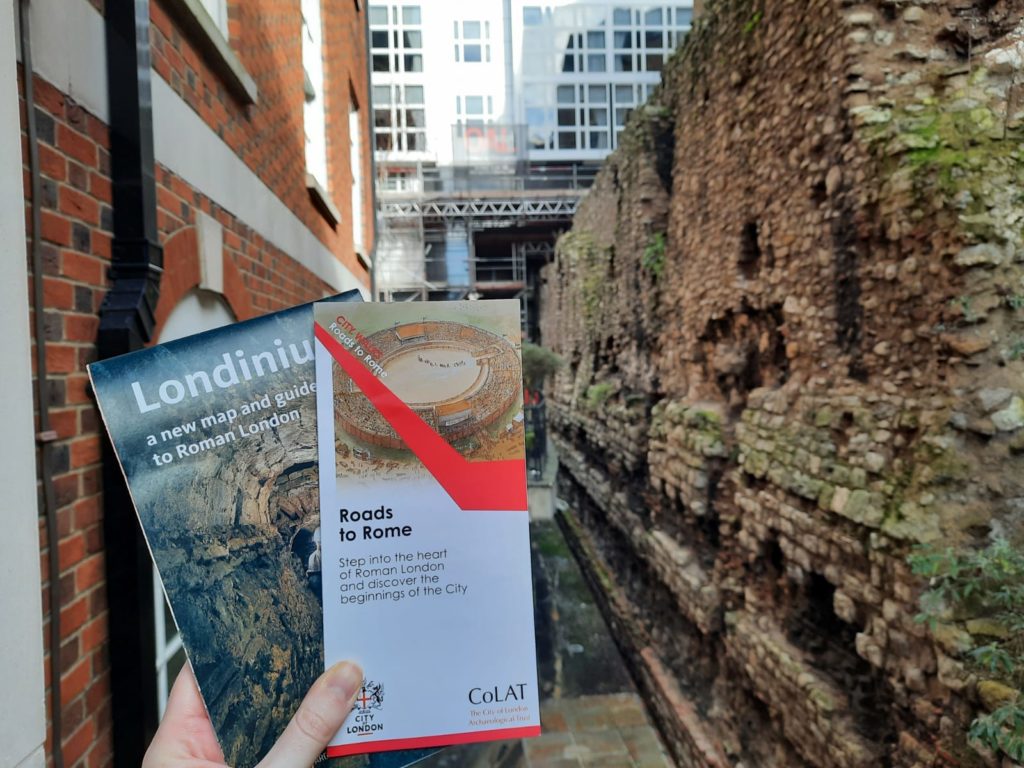
We Begin Our Walk – Cleary Gardens and the London Mithraeum
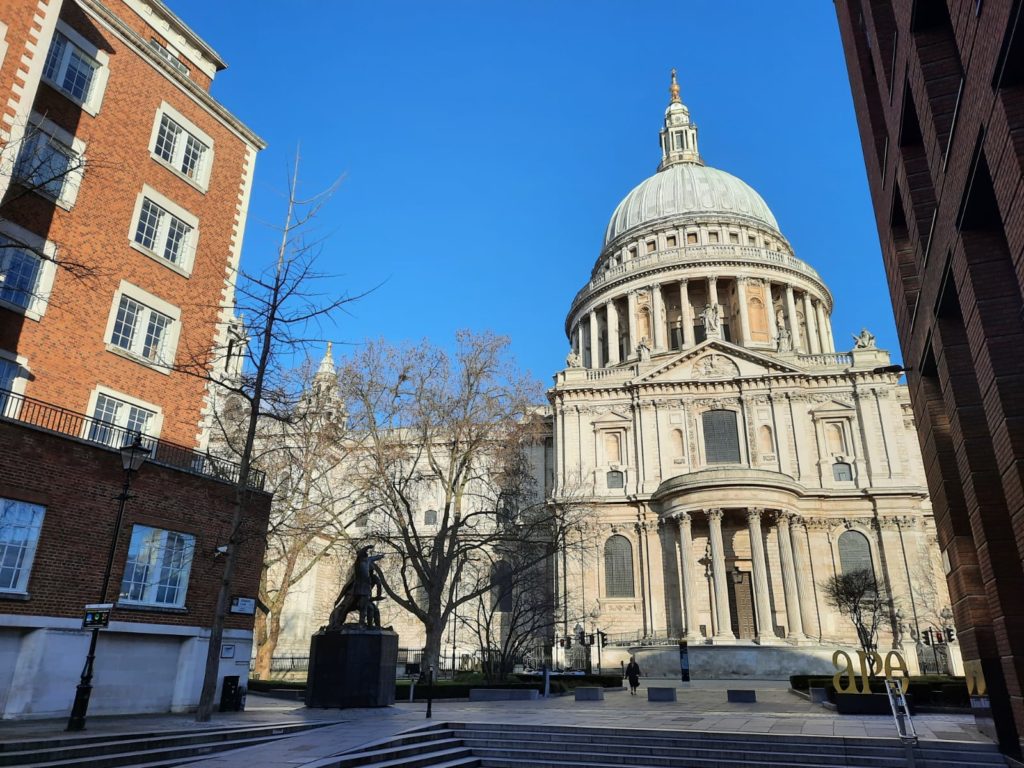
A Walking Tour in Roman London – London Stone to Billingsgate
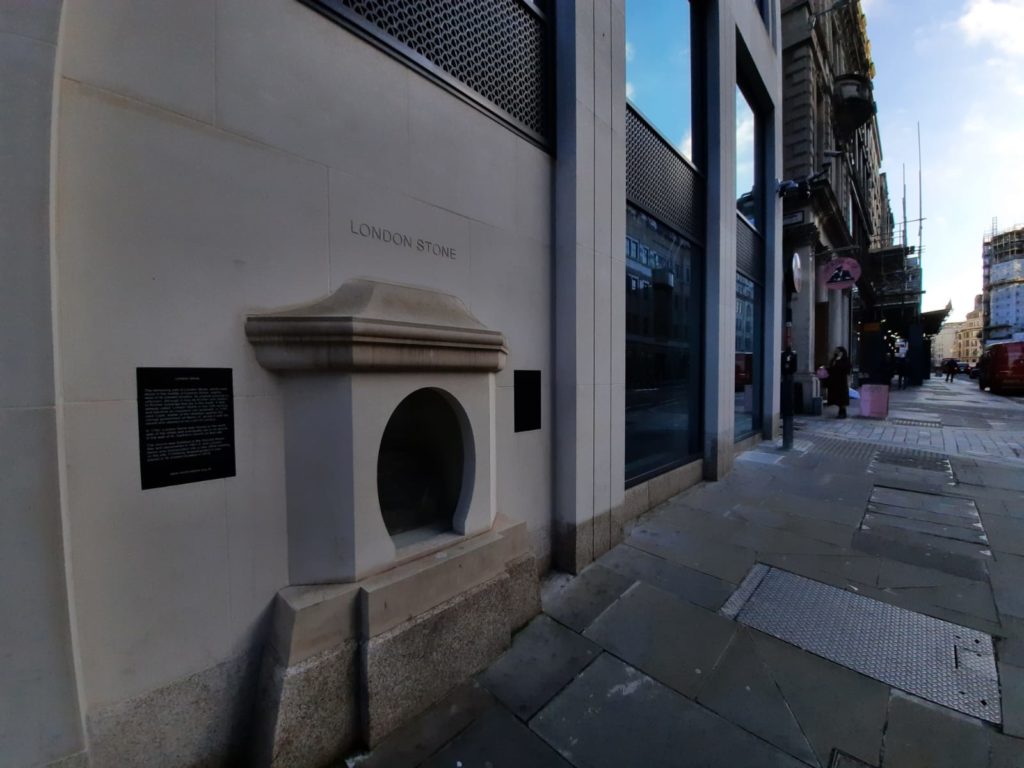
The London Stone is a very peculiar London oddity. Historic records go back to at least 1100, yet nobody quite knows what the point of it is. One possibility is that it’s a Roman distance marker. Today’s stone is a smaller fragment of a larger original. When I first moved to London it was behind a shabby metal grille, but got this nice new home in 2018. Under Cannon Street Station (across the street from the London Stone) a large palatial Roman building once stood.
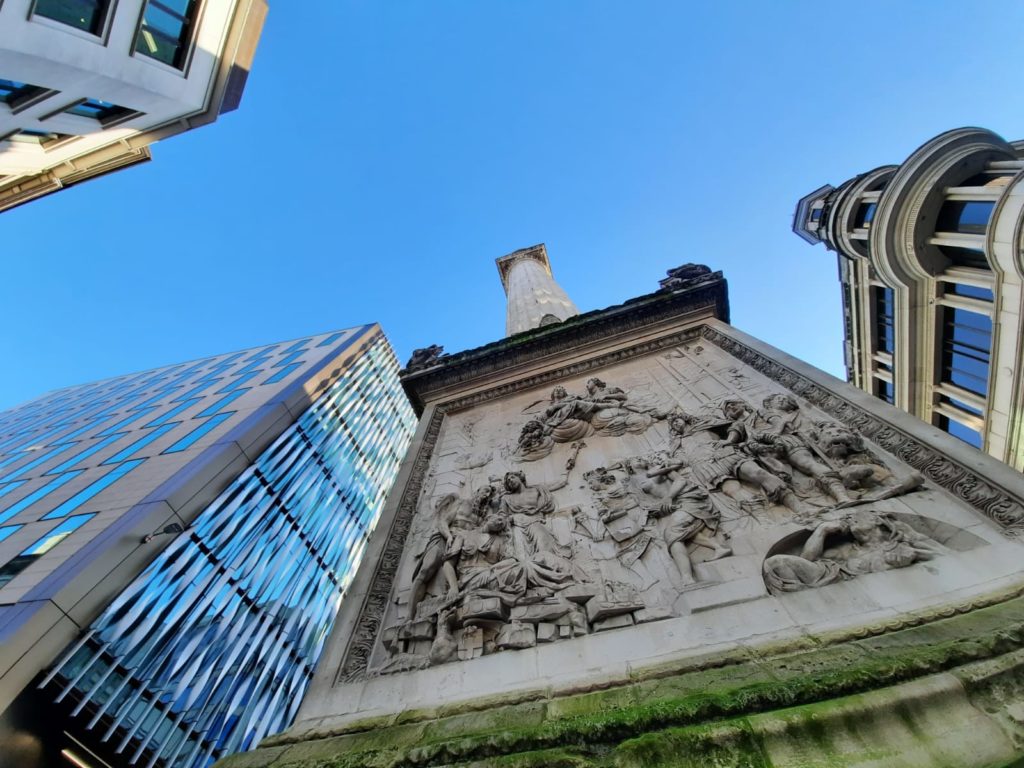
A Walking Tour in Roman London – Tower Hill to the Gherkin
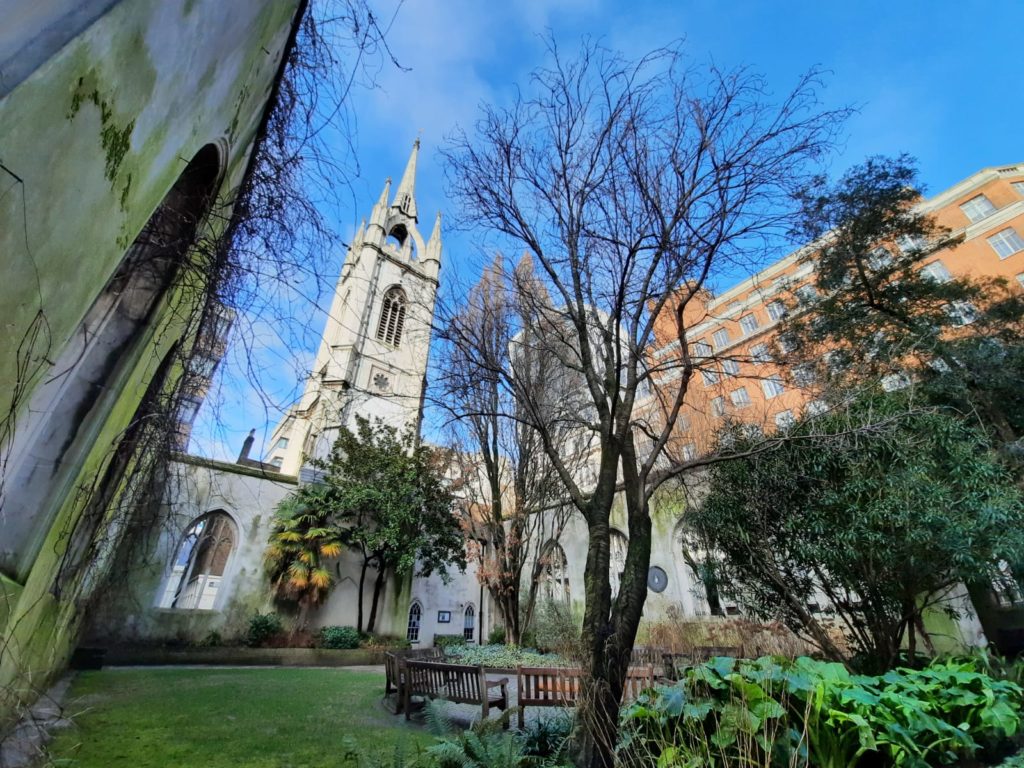
Maypoles, Spitalfields and the Guildhall
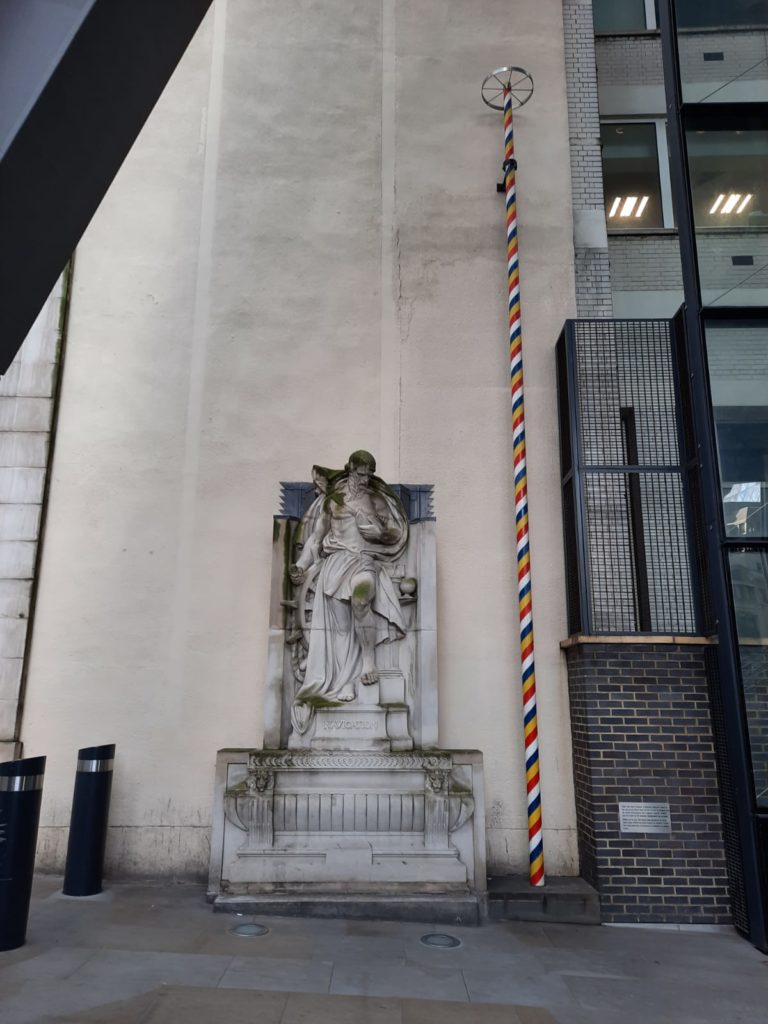
A Walking Tour in Roman London – St Alphage Garden to the Museum of London
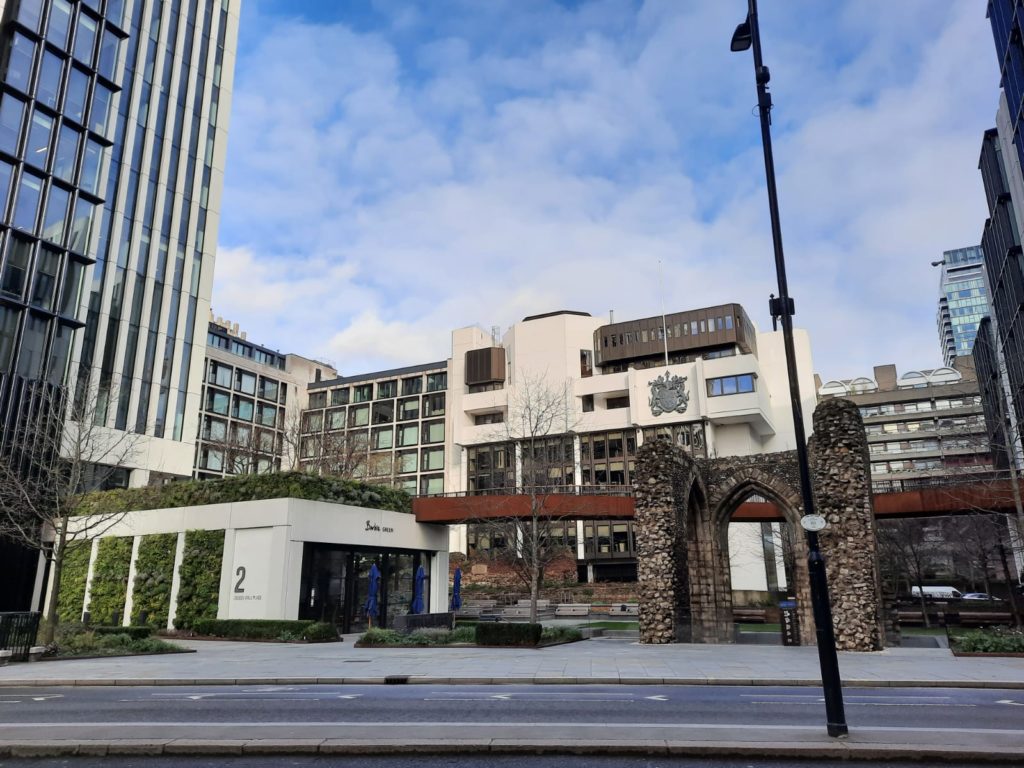
Want more ideas for historic walks in and around London? Sign up below for the Salterton Arts Review newsletter, delivered weekly.
Email address:
Travelers' Map is loading... If you see this after your page is loaded completely, leafletJS files are missing.
4 thoughts on “ Traces of Londinium – A Historic Walking Tour in Roman London ”
- Pingback: A Walk Along the Regent's Canal - Bethnal Green to Limehouse Basin –
- Pingback: The Great Fire of London - A Historic Walk –
- Pingback: All Hallows By The Tower, London – Salterton Arts Review
- Pingback: Mariana Castillo Deball: Roman Rubbish - London Mithraeum – Salterton Arts Review
Leave a Reply Cancel reply
Your email address will not be published. Required fields are marked *
Hello there.
Sign up below for the latest news and reviews, sent straight to your inbox once a week.
No, thanks!
Londinium: Explore The Remains Of Roman London
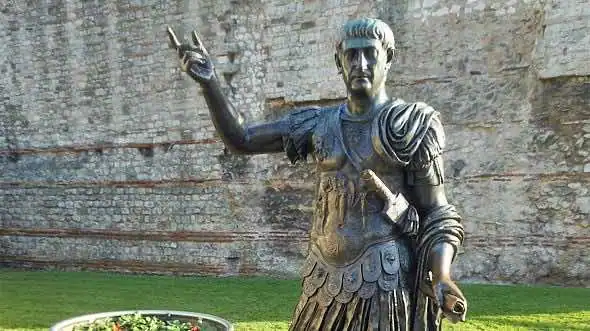
Craig’s review… The idea behind this walk is that we are going to be transported back in time to the year 50 AD, when the Romans first came to town and started building the wall. I have tried to include every little brick and piece of mortar that still exists from Roman times and lots of interesting sights and landmarks as well, because no one wants to look at a load of boring bricks all day. So it should be good.
Oh yeah… and before we start I need to tell you something. In order to get the most out of this walk you will need to dress up as a Roman (I’m being serious). So that means hiring a toga and a pair of sandals from the fancy dress shop. If you can get hold of a slave to boss around as well, then that will be perfect. I know that slavery is frowned upon these days, but who cares – let’s do it anyway! It doesn’t do them any harm does it. It’s not like we are going to whip them (that is optional). I am definitely going to whip mine, but I will leave that up to you.
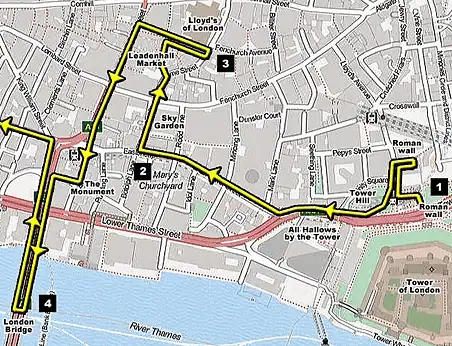
Let’s begin the day outside Tower Hill train station [see 1 on the map]. Right beside the front door is a huge chunk of the city wall that towers eight metres above your head (the roman bit only goes up to the first four metres). They’ve also got a big statue of the Emperor Trajan there pointing to the train station for some reason. Look for the plaque on the wall which provides a little bit of info about how the wall was constructed. It also shows you a map of where the entire wall used to run. Sadly practically all of it has disappeared now apart from this bit, a bit further north, and some big chunks by the Barbican – and we will visit all of them before the day is out.
To get to the next section you need to walk through to the other side of the station and turn right past Trinity Square Gardens. Keep walking for a tiny bit up Trinity Square and Cooper’s Row and keep your eyes open for the Grange City Hotel (it’s only a very short distance). You need to turn right into a courtyard at the Grange City Hotel. If you do it right then get ready to be impressed – this is easily the prettiest piece of wall still standing.
After that we’ll double back and enter Trinity Square Gardens. You get quite a nice view of the Tower of London from here, and if you head over to the far corner and search around for a bit, then you should come across the spot where they killed all of the traitors. This place is called Tower Hill , and you are standing on the exact same spot where they set up the axe and the gallows and thousands of people would gather around shouting and screaming for the drop. There’s a little plaque in the ground that lists all of the traitors’ names – famous names like Thomas Cromwell, Thomas More and the Earl of Essex.
But wait a minute… what has any of this got to do with Roman London? Absolutely nothing! But it’s still interesting nonetheless. But this next bit is definitely worth a look because you’ll get to see your first piece of Roman pavement. Can you see that church across the road with a green steeple? That is All Hallows-by-the-Tower . Have a nose around inside there and find a little flight of stairs at the back. This will take you down into a tiny little crypt. This is probably the last place that you’d expect to see some Roman stuff, but they’ve got a little museum down there with inscriptions and bowls and a big piece of mosaic pavement that is still in situ.
Once you’ve had a good look at that, keep moving down Byward Street, Great Tower Street and Eastcheap. As you walk down the road remember to look left across St. Dunstan’s Hill and St. Mary-at-Hill… because the Shard keeps popping up between the buildings. Turn right into Philpot Lane [see 2 on the map].
It was at this point that I stopped for my first coffee break. I’d only been walking for fifteen minutes but that was enough for me – it was teatime. I’ve got a thing about drinking posh coffees at those high street coffee shops at the moment – the ones that take about ten minutes to brew and end up costing you two weeks wages. There’s a coffee shop on the corner of Philpot Lane if you want to follow in my footsteps. Ask for a medium latte – because that’s what I had. And sit in the seat by the door too, and then you will have exactly the same experience as me. Remember to spill a bit of coffee on the table too, because that’s what I did.
Tea break over, head up Philpot Lane and one of London’s tallest skyscrapers will be towering over your head – the Walkie Scorchie. A few weeks after this was opened it famously started to melt all of the cars in the road below, because the curved glass focused all of the sun’s rays into the street. So if it’s sunny be extremely careful down here – I don’t want you bursting into flames (I won’t be liable for that, by the way, so you can’t sue me). There’s a tropical garden on the 35th floor called the Sky Garden that you can visit for free (as long as you print off a ticket on their website first). If you’re reading this in advance then I definitely recommend giving it a go just for the views alone.
Cross over the road at the end of Philpot Lane and enter Leadenhall Market . If you’ve never seen this place before then you’re in for a treat. It’s an old Victorian market with fantastic ironwork and red and gold gildings.
1,950 years ago we would have been standing right in the middle of the Roman Basilica, but nothing remains of it above ground today. Not unless you include a shop that sells spaghetti.
I’m going to make the route a bit confusing now… but I think you can handle it. One of the cross roads that leads out of Leadenhall Market is called Leadenhall Place. Walk to the end of that road and look left – I absolutely love this view. You are looking at Lloyds of London and the Gherkin [see 3 on the map]. Apparently the Romans were quite fond of eating gherkins, so that does at least have a little connection with Rome. Now walk back inside the market again and head out the opposite way into Gracechurch Street.
Turn left and keep going until you come to another London landmark… The Monument . You should see it’s flaming pot on top of a tall stone column when you get further down the street. Just keep walking until you see it on the left – you can’t miss it. Walk around it (or spend half-an-hour climbing up the 311 steps if you are mad), and then keep going over London Bridge.
We’re not actually going to cross over the whole of the bridge, just halfway, but it’s worth a quick pop down here just for the river views [see 4 on the map]. You’ll see our old friend the Shard again, rising high above the office blocks ahead, and the big battleship HMS Belfast moored in front of Tower Bridge. This is one of the best views of Tower Bridge , but it always seems to be very windy on this stretch of the river which makes your camera shake. This modern-day London Bridge is only about sixty metres away from the original site of the Roman bridge that spanned the Thames in AD 55, so if we were standing here 1,950 years ago then the banks would be full of Italians in togas and metal hats with feathers sticking out the top.

Now double-back the way you came but turn left down Cannon Street. I faced a little bit of a dilemma when I was designing the walk at this point, because no sane person would choose to walk down Cannon Street when King William Street leads to better things. But bear with me… because there is something down Cannon Street that is worth a look.
When you reach Cannon Street station look across to the opposite pavement. There should be a boring-looking grille on the wall [see 5 on the map]. Have a look through that grille and you will see the famous London Stone . Now this might be Roman, or it might not. And it might be medieval, or it might not. Or it might just be a boring lump of rock. Nobody quite knows.
Some people think that it was the stone from which Arthur pulled Excalibur. Other people think that it was the meteor which wiped out the dinosaurs. But whatever it is, it’s on display in Cannon Street.
Now turn right down Walbrook and walk to the end. I took a little detour at this point, but you don’t have to. It’s not part of the walk; but if truth be told I was knackered and I needed a rest. So I popped into St. Stephen Walbrook church and sat down and said a prayer for world peace. It’s quite a unique little church with a big slab of rock in the middle which doubles up as an altar. That’s the great thing about modern art – you don’t have to fork out thousands of pounds for a talented sculptor anymore, because you can just leave it as an unhewn lump of rock.
Back outside… turn right at the end of the street and enjoy one of the finest sights in London. Two of the buildings in this junction wouldn’t look out of place in Imperial Rome – Mansion House and the Royal Exchange . The Exchange could easily be a temple. It’s not though… it’s a shopping centre. You don’t believe me? Have a quick look inside if you’re brave enough (it took me a while to pluck up the courage to walk in there the first time I saw it).
Now head down Queen Victoria Street for some more buried Roman remains – the London Mithraeum (aka. the Temple of Mithras) [see 6 on the map]. The actual statues from the temple (or what’s left of them) are on show at the Museum of London … which is where this walk will come to an end.
Take a right into Watling Street (a good Roman-sounding name), and check out the little Dickensian side streets. Imagine if these places were lit by gas-lamps and dripped in fog. It’s the kind of place where Tiny Tim might come out hobbling on his crutches.
If you’re wondering whether Watling Street follows the line of the original Roman Watling Street, then it doesn’t – but it might be very close. Some archaeologists believe that it ran from Greenwich up to Westminster, bypassing the north bank completely, whilst others insist that it came over London Bridge and continued in a straight line through Bishopsgate. Other experts have picked out a section that runs through Park Lane and the Edgware Road. So they basically haven’t got a clue. But they can all agree that the odds of it running along the same line as the modern day Watling Street is zero.
At the end of Watling Street you’ll find the back end of St. Paul’s Cathedral , so walk through the gardens on the lefthand side until you come round to the front steps. Then stop and say another prayer. I prayed for world peace again, and also for an end to world hunger and a cure for all known diseases. They’ve got a little restaurant and some toilets downstairs, so this is the perfect place for a break. Don’t enter the cathedral through the front door though (that’s the bit you have to pay for) – you’ll find the entrance to the Crypt around the lefthand side if you’re looking at the cathedral from the front [see 7 on the map].
Now walk through St. Paul’s Churchyard (the gardens on the opposite side) until you come to Cheapside, and then check out St. Mary-le-Bow church halfway down. I actually went inside here but you don’t have to (I needed another sit down you see – my dodgy knees were killing me today).
There was a nice smell of incense floating around and the priest was pottering around having a little bit of a tidy up. The place was full of wooden school chairs – what is it with school seats in churches? They’ve even got those in St. Paul’s. It makes me think of being back at school with the teacher at the front. Here’s one famous thing that I can tell you about St. Mary-le-Bow church… you have to be born within the sound of its bells to be a true cockney.

Keep walking down Cheapside and take a left down King Street, and you’ll see the facade of the medieval Guildhall straight ahead, where the Lord Mayor holds all of his City meetings [see 8 on the map].
Next door to the right is the Guildhall Art Gallery . Not very Roman, you might think (it certainly doesn’t look Roman) – but wait! What is that big grey ring of bricks that I spy on the forecourt? Well, that is none other than the original site of London’s Roman amphitheatre! How about that then? You weren’t expecting that, were you? So if we were standing here 1,950 years ago we could have enjoyed one of those Christians v The Lions sports shows. Personally I would have put my money on the lions every time. And what is even more exciting is that you can actually visit the Roman remains in the basement of the art gallery – it is totally free to enter, so there really is no excuse not to go and have a look – it’s probably the highlight of this Roman walk.
The tour gets a lot more interesting from this point on, because there are some really big pieces of Roman masonry coming up. Take a stroll up Gresham Street and bear round to the right at Noble Street. If we travelled back in time then we would now be entering the southern section of the Roman fort (which was located in the northwest corner of the city). Down the side of the street you’ll see what remains of the outer wall [see 9 on the map].
Unfortunately it doesn’t look very old anymore because it’s all been built over with bricks, but the foundations are still big and rocky like you would expect them to be. I think the Germans bombed this bit of London in the 1940s, and uncovered a lot of what you can see. So that is something that we can thank Hitler for at least – at least he did a bit of archaeology for us.
Carry on walking over the busy main road (called London Wall – where the northern edge of the city once ran) and you’ll see a little curved road down to a car-park – it’s slightly to the right of Noble Street, and heads downwards towards the left. Head down there and you will see some more wall that rises to quite a height. This time it’s a curved section that once formed part of a bastion tower. You are allowed to walk over the grass and follow it up the western edge of the fort – those offices on the right are where the barracks would have been. The wall carries on for quite a distance, and when you get to the end you’ll be treated to a nice little surprise – it opens out into a big pool of water, complete with another corner turret. It’s almost like a moat around the fort. You won’t be able to get any further unfortunately because there’s a big green gate that bars your way (unless you’ve bought some dynamite with you), so double back the way you came and head up the car park ramp to the road again.
This time we’ll take the stairs that you can see to the left. I don’t mean the concrete ones to the right – they are definitely on the left as you come up the ramp, and it should be signposted ‘Barbican Centre’ and ‘Museum of London via Highwalks’. We want the Barbican Highwalk.
Now be careful around here, because it’s notoriously easy to get lost in this place – if you don’t lose your way at least once then you will be doing very well indeed. It’s like a big concrete maze of high walks that goes up and down and round and round in circles. Someone actually got lost in here once and staggered out five years later. They had to send a search party in, which also got lost. Then they sent Ranulph Fiennes in, and he got lost as well. That is how easy it is to get lost in here. So you might want to take a packed-lunch and some bottled water with you, just in case.
Once you are on the highwalk turn to the left and keep going past the little parade of shops. Then turn left into ‘The Postern’. Resist the temptation to go down ‘Wallside’, and keep going until you come to the stairs near the end of The Postern (on the left). This will take you down to the ground level again, and plop you right in front of St. Giles Cripplegate church [see 10 on the map]. If you do a lap of the church then you will see the other side of that circular tower that we saw earlier, standing proud beside the moat. There is also another huge chunk of Roman wall along the water’s edge – the final section on our walk.
All that remains now is for you to find your way back, and not get lost. Can you remember the way back? If you can’t then that’s unlucky because I can’t be bothered to give you directions, ha ha. You should have dropped some breadcrumbs! Now you are going to be stuck in here for days and will probably die of hunger. Ah well. (I am not liable for that, by the way. So you can’t sue me.) I will keep an eye out for you the next time I visit… which will probably be in about six months.
If you manage to re-pass that little parade of shops then there is just one more thing to do… don’t go down the starting stairs again, but carry on in a straight line towards the Museum of London . If you’re not totally knackered from all the walking then it’s worth looking inside the museum to see all of the Roman remains they’ve got on display (including that Temple of Mithras stuff that we saw earlier). It’s all free and what’s even better… they’ve got a cafe and some toilets too!
Share this page Share on Facebook Share on X (Twitter) Share on WhatsApp Share by email
Your comments and questions
M&L Thank you for this very interesting walk. We will have to visit London again as we got caught up in interesting bits and distractions along the way, and ran out of time just at the best part at Noble Street. Thanks, again, from Ottawa, Canada.
Maggie Your site is THE BEST about London! I have been to MANY site & yours is the most thorough & interesting. It is a ONE STOP SHOPPING site for anyone who wants to visit London! Thanks, Maggie in Ohio, USA
You must enable javascript to leave a comment

London’s Roman Wall: A Self-Guided Walk

It is difficult to picture now, but for most of London’s history, the shape of the city was defined by its huge perimeter wall.
Walking the route of the old Roman and medieval city walls, is a great way of getting in touch with London’s past. It is also a very pleasant walk that takes you through some fascinating parts of the city.
Here is my suggested self-guided walk (roughly 4km). Along the way you’ll find crumbling medieval towers, great imposing walls and ruins in some surprising places…
Introduction
No-one can quite agree why the Romans decided to build a wall around Londinium, as it was known then. Nevertheless, in 200AD, the wall was built and was one of the largest construction projects in Roman Britain. Over the medieval and Tudor periods, the wall was added to, maintained and enhanced.
Below is a brilliant map from Layers of London of Tudor London showing the wall, its moat and gatehouses. I will use sections of this map throughout the walk to help you get your bearings.

In the 18th century, as London expanded, the gates and parts of the wall were destroyed, primarily to improve traffic flow. The remaining ruins are now scheduled monuments, often looking slightly adrift in a sea of glass and steel.
Along the way you will see these plaques (below)- laid out by the Museum of London in the 1980s. They have some very interesting pictures and text but don’t bother trying to follow their suggested route as lots have been lost over time.

Start: The Tower of London and Medieval Postern Gate
When William the Conqueror built the Tower of London in 1077 he incorporated a section of Roman wall into it. This was unfortunately lost during medieval upgrades to the Tower. You can still see the line of the old wall however inside the Tower, should you visit.

For our first stop we are at the ruins of a medieval postern gate. Built between 1297-1308, it was located at the point where the wall met the moat of the Tower of London. It was used as a pedestrian gate and defensive tower, right up until at least the 17th century.
The postern gate was uncovered during excavations in 1979 and had only survived because part of it had subsided and was buried in 1440.

Tower Hill Roman Wall

This is where you can see one of the best surviving sections of London’s wall. In the Roman period it would have been roughly 6m tall and is now 10m due to medieval additions. It gives you a great sense of how imposing the wall would’ve been to those inside and out.
The Roman wall was built predominantly of Kentish ragstone (roughly one million blocks) brought on barges from Maidstone.
To work out which bit is Roman, look out for the lines of red tiles. The Romans included these horizontal lines to strengthen the structure, possibly as a spirit level during construction or possibly to stop damp rising through the wall.

This Eastern section of the wall in the Roman period had up to 20 bastions (projecting parts of the wall from which to defend).
The statue was installed here in the 1980’s and is thought to be of Emperor Trajan. He did not have anything to do with the wall and never visited Britain but it adds a nice bit of atmosphere I think!
Cooper’s Row
Walk to Cooper’s Row and through the entrance/carpark area of the Leonardo Royal London City hotel. This is probably the best surviving section of the wall.
You can still see archer’s loopholes here in the medieval section of the wall. According to the Museum of London there would have likely been a timber structure behind the wall to give archers access to these holes.

It appears to be sitting in a trough due to the rise in ground level since the Roman period.
The name Cooper’s Row comes from the coopers or cask makers who used to store their casks in the recesses in the wall here.
How has it survived? Well, over the years it became incorporated into the foundations and walls of industrial and residential buildings. It was rediscovered during the construction of a warehouse in 1864. It was decided by the then owner of the warehouse to preserve the wall. During excavations in 1962 the remains of a rectangular Roman turret were discovered which likely had a stairway within it to access the parapet.
Walk along Vine Street for our next stop. There is a stretch of Roman Wall in the basement of the buildings on your left, currently a building site. Included in the building works there is apparently a plan to fit viewing panels.
You will now be where the Aldgate used to stand: one of the seven gates in the city walls. This open area still has a palpable feeling of being on the edge of the city. A gate was built here by the Romans over the road to Colchester: one of their major thoroughfares.

The etymology of the name ‘Aldgate’ is disputed. Theories include that it comes from ‘Aeld Gate’, i.e. ‘Old Gate’, ‘All-gate’, meaning that it was free to all, or that it comes from ‘Ale-Gate’ in relation to an ale-house.
Geoffrey Chaucer, of Canterbury Tales fame, lived in rooms above the Aldgate from 1374 whilst he was a customs official for the Port of London. More on some of the other uses of the gates below in the Bishopsgate section!

It was pulled down in the 18th century with the rest of the gates.
Note the name of the church here (also on the map): St Botolph without Aldgate- meaning it was outside the Aldgate. St Botolph was the patron saint of travelers. A church dedicated to him is therefore often found at the city gates, for people setting off on their travels! We will see a couple more on our walk.
Have a look at the plaque here about the archaeological dig on this site in 2013.

Houndsditch
As you set off on the next section of the walk, note the street name- Houndsditch. There was a outer ditch around the exterior of the wall. The name Houndsditch is thought to be named for the fact that this particular area of ditch was a popular spot for the Romans to dispose of their dead dogs. Indeed, during 20th century excavations, quite a lot of dog skeletons were found here! You can see it on the map above.
The plaque on the side of Bevis Marks synagogue has a good depiction of the area in the time of Elizabeth I.
Bishopsgate
Again, there is nothing left of Bishopsgate, but the bishop’s mitre adorning the wall of Boots is a nod to what was once here.

Bishopsgate was burnt down by the Yorkists, who attacked London in 1471 during the Wars of the Roses. It was rebuilt by merchants in exchange for steelyard privileges. Bishopsgate was famous for, along with other gates, having the heads or body parts of recently executed criminals displayed on spikes atop the gate!
A curfew was rung by the church bells at 9pm. At this point the gates and portcullises were shut and only opened at 6am or sunrise, whichever came later. During the night, citizens would have to stay in their houses and no-one would be allowed into the city.
As well as for security, the gates were also used as checkpoints to collect any tolls and often also as prisons.
Again, note the church St Botolph without Bishopsgate here.
All Hallows On The Wall and Moorgate
You will now follow the road: London Wall, which more or less follows the line of the old wall.

All Hallows On The Wall church was built around 1120AD on one of the old Roman bastions. It would have been neatly tucked against the wall and indeed the foundations of the Northern wall of the church incorporate some of the Roman wall.
This proximity to the wall meant that it managed to survive the Great Fire in 1666. It was rebuilt in 1765 by George Dance the Younger.
The section of wall by the entrance to the church is mainly 18th century but incorporates some of the old medieval wall. You can see the church tucked against the wall and bastion on the map below.

On the way to the next stop you’ll pass by the site of Moorgate. It is first mentioned in the early 15th century as a small postern gate and replaced with a bigger one around 1415. The name ‘Moorgate’ comes from the marshy land or Moorfields just outside the Northern wall.
St Alphage Wall

We now arrive at the site of the original Roman fort or ‘Barbican’. Built around 120AD, the Barbican was in place before the wall and would have housed 1000 Roman soldiers. You can see its location on the map above. When the wall was constructed it incorporated the Northern and Western walls of the fort into it.
Here you will find the ruins of the church St Alphage. Similar to All Hallows On The Wall, the first mention of the church was in the early 12th century and it was built adjoining the wall.

The church fell into decay and at the turn of the 20th century was partly dismantled. It then was gutted during the Second World War. The remains of the 14th century tower with its ghostly arches are now grade ii listed.

The former churchyard is bounded on the North by a significant remaining section of Roman and medieval wall, exposed partly by Second World War bombs. The upper portion of the wall is thought to have been added during the Wars of the Roses, when London really was under threat.
On the map below you can see the church.

Cripplegate
The Barbican we know today; the post-war brutalist social housing estate, was of course named after the fort. The fort is also remembered in the names of the walkways such as ‘The Postern’ and ‘Bastion Highwalk’.

You will first come across the site of the Cripplegate: a gate added into the Northern wall of the Roman fort.
The name is thought to come from either; the old English word ‘crepel’, meaning a low passageway, or named for the ‘cripples’ who would beg for alms here. In the reign of Charles II (1660-1685) all the gates were wedged open and doors unhinged. From then on they provided more of a ceremonial entrance than a defensive one.
You will see the church of St Giles without Cripplegate , originally built in 1090 (also on the map above). The Church has a fascinating history: Oliver Cromwell was married here and John Milton is buried here. Pop in and have a look around if you get the chance!

The Barbican Walls And Tower
The wall you can see here is predominantly medieval. Make sure you look out for the remains of some of the towers that would have punctuated the wall. The lake is a brilliant reminder of the defensive moat/ditch that ran around the exterior of the wall.

The medieval tower at one end of the wall marks the North Western corner of the fort and wall. It became largely buried over the years and was only uncovered by bombs in the Second World War. It was fully revealed during the subsequent building of the Barbican estate.
In peacetime the towers were used for all sorts of purposes, with this one thought to have been occupied by hermits.

Museum of London Tower
I believe you now have to circle back round onto Wood Street and then along London Wall but there may be a quicker way! (The Barbican can be a bit of a maze).

Here you will see another tower, added in the 13th century to strengthen the defences of the Roman Wall. It became a house in peacetime with the arrow-slits acting as the windows.
Again, Blitz bombs revealed this tower after it had been essentially incorporated into, and obscured by, buildings since the 18th century.
Barber-Surgeon’s Hall Tower

Here you will see another defensive tower installed in the 13th century. It became incorporated into the Barber-Surgeons Hall in the 17th century.
It was heavily damaged in the Great Fire of London in 1666 and again the Blitz when both the hall and tower were pretty much destroyed. The new Barber-Surgeons Hall on your right was built in 1969.
Carry on walking round to see the Barbican medieval tower from another angle.
Before heading over to Noble Street for the final impressive section of wall, you can head into the subterranean depths of the London Wall carpark. In bay 53 you will find, not a car, but another section of the wall! Be warned, it is a very long carpark…

Noble Street Wall and Aldersgate
Here is the final section of wall that is visible to us now. It also was uncovered by World War Two bombs and Roman sections can be seen at the bottom.
Towards the end you will see the remains of a sentry tower that would have been used to access the parapet of the wall.

At the end of this stretch, turn right and you will come across the site of Aldersgate. This gate was added in the later Roman period.
End: Newgate, Ludgate and Blackfriars
We will now follow the line of the wall down past the final 2 gates: Newgate and Ludgate. Both were similarly imposing gates with a double roadway and flanking guard towers. Newgate was used as a prison from at least the 12th century.
The name Ludgate is thought to probably derive from ‘flood gate’ or ‘Fleet gate’ as it led out to the, now buried, River Fleet . Alternatively it may come from ‘ludgeat’, meaning back gate. The statue of Queen Elizabeth I, on the outside of St Dunstan in the West on Fleet Street, used to be on the Ludgate. It was carved in her reign and is the only public statue of Elizabeth in London.
You can see a plaque denoting the site of the Ludgate on the side of St Martin Within Ludgate.

We finish the walk down by Blackfriars station. The Romans did also build a stretch that ran along the banks of the Thames in the late 3rd century but none of this remains to be seen today. It is thought that this was eroded and destroyed by the river in the subsequent centuries.

The Blackfriars Monastery, eventually dissolved in the 16th century under Henry VIII, was set up in 1278 outside the city walls. However, later on in the 13th century, the walls were moved westwards to incorporate the monastery.
So there we have it, I hope you enjoyed. If you go on the walk, do let me know!
More London history walks and hidden gems below …

A Look Inside Watermen’s Hall

Bernie Spain Gardens: A Small Park With A Big Heart

The Medieval Ruins By Salters’ Garden

Spencer House: A Georgian Jewel In St James’s

The Onion Garden: Westminster’s Hidden Green Oasis

Ten Hidden Details At The Churchill War Rooms
Share this:, 20 thoughts on “london’s roman wall: a self-guided walk”.
Thank you Jack! I enjoy your posts!
You are very welcome, I’m glad you are enjoying them!
Love your posts, so interesting. X
Hi Debbie, thanks so much! Really glad you’re enjoying them 🙂
Thank you so much-very interesting!
Another great post! It is getting hard to say which one is my favorite! Travelling around with this one! Thank you for sharing the pics and the maps!
Hi Priscila! Thank you, really pleased you liked it 🙂 it’s a fun walk!
Pingback: London Mithraeum: A Hidden Roman Temple Under The City - Living London History
Pingback: The Roman Relic Hidden In Clapham - Living London History
Pingback: A Georgian Gem Hidden In A Clapham Council Estate - Living London History
Pingback: Info og tips for Blackfriars og deromkring – London bortenfor Oxford Street
I have been researching our trip to London in June of this year and found you on Twitter. I have been reading all of your older posts and am so excited to discover that the hotel we are booked to stay in- The Leonardo Royal London City- is home to such a well-preserved bit of Roman wall. Wow! Thank you so much for your well researched and interesting posts; I’m finding so much to see when we are in town! I am also hoping to snag some spots on your Secrets of the City tour while we are in town. When will you be listing the walk dates for June 2023?
Pingback: Discovering The Remains Of London's Roman Amphitheatre - Living London History
We did it as a team activity last Week and we really enjoyed it.
Thanks for this. Your post really facilitated it for us.
That is great to hear thank you! Really pleased you enjoyed the walk. Best, Jack
Pingback: 8 Amazing Architectural Details To Spot At The Barbican - Living London History
Pingback: A WRITER’s RABBIT-HOLE | Sian Turner
Many thanks for your Roman Wall walk information. It helped inform a walk I hosted for a MeetUp Group – much appreciated by all. I have left a link in our MeetUp site to your own site.
I’m a Kiwi with a fascination for Romano Britain and I’m in UK now on my dream holiday…. Thank you so much! I followed your directions, found everything, learned so much and now have some fantastic memories and excellent photos.
Leave a Reply Cancel reply

Touring the Enthralling Roman Ruins in England
There are scores of great ancient Roman ruins in England! Check out this guide to learn where they are and how to create your own DIY ancient Roman road trip!
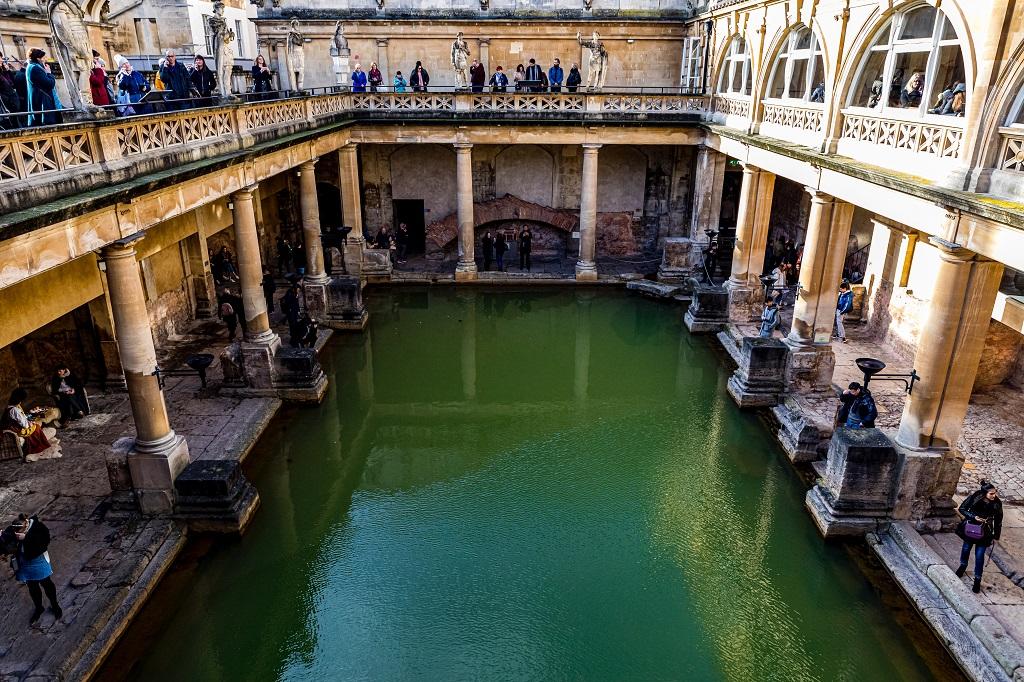
When considering empires, the Roman Empire was certainly one of the most influential of the past few millennia. Remains of this mighty empire can be found everywhere from Turkey to England. Ruins range from collapsed walls to entire cities full of villas and forts. Many people know the Romans could be found throughout Continental Europe. Did you know there are Roman ruins in England? Not many realize how far the empire also expanded into Great Britain. London and the English countryside are actually dotted with amazing archaeological sites left behind by this ancient civilization. An English road trip is a must-do for history lovers!
One of the best ways to see England’s expansive list of Roman ruins is by organizing a DIY road trip. You’ll get the chance to spend as much time at each of the archaeological sites as you want. Plus, you get to stay in charming English villages and historic cities. To help make it easier to plan your trip, we’ve organized the ruins from south to north, starting from London.
Stepping Back in Time With Let’s Roam
If you love to learn about topics like Roman ruins in England like we do, we have a treat for you! Our educational and fun-filled scavenger hunts are specially designed to take you into the nooks and crannies of the world’s most fascinating cities. With hundreds of hunts throughout Europe, Asia, and Africa, there’s sure to be one near you! Download the Let’s Roam app today! Don’t forget to also check out the Let’s Roam Explorer blog , which is loaded with great articles and to-do lists written by our team of in-house travel experts.
Roaming Roman Ruins in England
One of the best places to view Romano-British ruins in England is in London itself! The City of London was once an important port of the Roman Empire. Around 200 AD, they built an extensive 2.5-mile-long wall. It was built with fortifications around it to protect this important city, then known as Londinium. It was eventually abandoned in the 5th century. At one point, it had an extensive road network, a Roman amphitheater, beautiful temples, and bustling markets.
Today, you can start your journey into Roman London at the Museum of London. It has a substantial collection of Roman coins, household goods, and religious figures. There’s also a sizable chunk of the Roman wall located next to the museum. From there, it’s time to go explore! You can still see remnants of Roman London hidden throughout the city. There are sections of the wall in Tower Hill and Blackfriars. There’s an amphitheater in Guildhall. See the sections of Roman road in Southwark Cathedral and in All-Hallows-by-the-Tower! There’s even a Roman supporting pier of a Roman basilica in a barber shop in Leadenhall Market!
While you’re in London, don’t forget to do our invigorating London scavenger hunt . This hunt will take you to places like St. Paul’s Cathedral, Bank Junction, and Leadenhall Market, plus many more spots!
South of London
There are a number of ruins located south of London. Some of these can be done on a day trip. Others may be best left to do as a longer overnight trip. That way, you can visit multiple archaeological sites over a few days. This is a great place to start exploring England’s Roman ruins, especially if you don’t have time to venture much further north in the country.
Richborough Roman Fort, Kent
Founded by the Romans in 43 AD, the Richborough Roman Fort quickly became an important British port. That was thanks to its location near the mouth of the Stour River in the southeastern tip of England. During a visit, you can see the huge stone walls of the fort, rolling defensive ditches, and the foundations of long-gone buildings. The importance of the Richborough Fort declined as nearby Dover grew. It was eventually abandoned by the Romans in the fifth century. It was then occupied by the Saxons, and there’s evidence of this period visible as well.
Richborough is located about a two-hour drive southeast of London. It’s around a 20-minute drive from the White Cliffs of Dover. The two sites can easily be combined into one great day trip from London.
Fishbourne Roman Palace
Located near the West Sussex cities of Southampton and Brighton in Chichester, the Fishbourne Roman Palace is the only Roman palace still standing in Britain. It has the largest collection of mosaic floors in the country! A large section of the palace was destroyed in a fire in the late 3rd century, and parts of it were demolished shortly after. The palace was eventually abandoned and then dismantled.
Excavations have uncovered much of the old palace. You can freely wander through recreated Roman gardens, imagining what it would have been like to be one of the wealthy owners who lived there. It’s less than a two-hour drive southwest of London. Combine it with a visit to the Brading Roman Villa on the Isle of Wight and the Bignor Roman Villa just west of Chichester. Like Fishbourne, both excavated villas offer colorful mosaics depicting plants, animals, and even Medusa!
If you still haven’t gotten your fill of ancient Roman residences, you can continue driving west to Dorchester. Here, you’ll find the remains of a fourth-century Roman townhouse. This is the only fully exposed Roman townhouse in England.
The Roman Baths of Bath
As some of the most famous Roman ruins in England, the Roman Baths of Bath were some of the biggest religious spas in the ancient world. A temple was built here between 60 and 70 AD. People came from far and wide to worship the goddess Sulis Minerva and bathe in the waters of the area’s natural thermal springs. A Roman town eventually developed here to support the baths. It became known as Aquae Sulis.
While you can no longer take a bath in these waters (at least not here!), you can still explore the Roman Bath complex. View the ruins of Sulis’ temple and admire the original Roman pavements so perfectly laid out! The complex is divided into four main sections. These include the Sacred Spring, the Roman Bath House, the Roman temple, and the on-site museum. Check out the artifacts excavated from the Roman town!
Bath is located about two hours north of Fishbourne Roman Palace and about 90 minutes from London. It’s a great place to stay for a few days if you need a little break from ancient Rome and want to enjoy some of the luxuries of modern-day life.
North of London
There are some fantastic Roman ruins located north of London, most notably the renowned Hadrian’s Wall complex. This area is best tackled as one long road trip. Most of the major sites are a bit too far to reach in one day, unless you really, really like driving on tiny English roads. We highly recommend taking your time. Give yourself the opportunity to take in the stunning scenery and enjoy the adorable towns. This way, you’ll avoid ancient Roman burnout (trust us, it happens) and experience the best of what England has to offer.
Verulamium Museum and Park, St. Albans
Located in Hertfordshire about an hour northwest of London, Verulamium was one of the largest cities in Roman Britain. There’s an impressive array of ruins to see there today, including an ancient central heating system and theater dating back to 140 AD. The theater is unique as it features a stage that could have been used for religious ceremonies.
Just a short walk from the museum complex, you’ll also find the Hypocaust. This ancient underfloor heating system is one of the most impressive aspects of Roman engineering. Remnants of this system can be found at archeological sites all over the former Roman Empire. They’re endlessly impressive. St. Albans is just over an hour’s drive north of London and is the perfect place to start on the northern leg of your Roman journey!
Chedworth Roman Villa, Cirencester
Located just north of the city of Cirencester, the Chedworth Roman Villa was once one of the fanciest Roman villas in Roman Britain. It had not one, but two bathhouses, in-situ Roman mosaics, and marble features. It was constructed in the 2nd century and continuously expanded and improved. Although no one knows for sure who the owner was, it was clear that they were wealthy and well-educated.
Cirencester is around a two-hour drive west of St. Albans and can be included as a stop when traveling between St. Albans and Wroxeter Roman City.
Wroxeter Roman City, Shrewsbury/Shropshire
Founded in 55 AD as a frontier post and rediscovered in the 19th century, the Roman city of Wroxeter was originally called Viroconium after the local British tribe of the Cornovii. It was once one of the largest settlements in Roman Britain and had a population of more than 15,000 people. That makes it nearly the same size as the much more famous city of Pompeii.
Thanks to its well-preserved ruins, Wroxeter Roman City was one of the first Roman archeological sites to become a major tourist attraction in the UK. Here, you can see the remains of an enormous Roman bathhouse. Gawk at the largest piece of free-standing Roman wall in England and wander through a reconstructed Roman townhouse. There’s also an on-site museum. Learn more about daily life in ancient Rome by viewing the artifacts that were found there!
The ruins are located about a three-hour drive northwest of London just north of the city of Birmingham and a short distance from the northern border of Wales. If you’re planning to continue north from there, you may also want to stop at the Chester Roman Amphitheatre. Located about an hour north of Wroxeter, it was the largest amphitheater in Britain. It’s believed to have been used for everything from military training to cock fighting.
Aldborough Roman Town, Boroughbridge
This North Yorkshire site was once the capital of the Romanised Brigantes who were the largest tribe in Britain during the Roman era. Once they were subdued by the Romans, their original fort was replaced by the town of Isurium Brigantum. Today, you will find the remains of a town wall complete with defensive towers and two mosaics that were once part of an elaborate Roman townhouse. The on-site museum gives a fascinating look into this Roman city! There are also guided tours that you can join to learn more about the site.
Boroughbridge is located just a short drive north of Leeds near the North York Moors National Park and the Yorkshire Dales National Park.
Hardknott Roman Fort, Cumbria
This Roman fort, known as Mediobogdum, was built between 120 AD and 138 AD to protect the valuable Hardknott pass. It was garrisoned by the Fourth Cohort of Dalmatians, a unit that included around 500 men. The site is home to the ruins of parade grounds, Roman roads, ancient quarries, and Roman baths. Although there isn’t a huge amount left there, the fort is perched around 800 feet above the ground. You can get great views of the nearby River Esk, making it pretty easy to see why they decided to build a fort there!
Hardknott Roman Fort is located within the Lake District National Park around six hours north of London and about a two-hour drive southwest of Hadrian’s Wall. You can easily combine it with a visit to Aldborough Roman Town, which is about a three-hour drive away.
Vindolanda and the Roman Army Museum
One of the best-preserved Roman sites in England, Vindolanda gives a fascinating look into the daily lives of the people who once lived in the area. Located in Northumberland, Vindolanda began as a Roman auxiliary fort just south of where Hadrian’s Wall would eventually stand. It was under Roman occupation from the late 1st century to the late 4th century and was home to soldiers, families, and traders.
Today, you can view the ruins of civilian houses and workshops. There’s a Roman temple and latrines as well as replicas of a Romano-British house. Don’t miss the sections of Hadrian’s Wall. There is also an on-site museum with a rotating collection of artifacts, including the famous Vindolanda Tablets. These tablets were tucked under the floors of the ancient structures. They give an in-depth look into the private lives of Roman citizens.
The adjacent Roman Army Museum gives insight into the lives of Roman soldiers and what it would have been like to be stationed along Hadrian’s Wall. You can see artifacts found at Vindolanda on display. These include weapons, armor, Romain coins, and more. Nearby, you can also find the Housesteads Roman Fort. Here, you can see some of the oldest Roman toilets still in existence.
Hadrian’s Wall and the Temple of Mithras, Carrawburgh
The creatively named Hadrian’s Wall once marked the border between Roman Britannia and Caledonia (modern-day Scotland). It was built in 122 AD during the reign of Emperor Hadrian and still stretches a whopping 73 miles across northern England, which makes it the largest Roman archaeological feature in Great Britain and a UNESCO World Heritage Site. From the east, it starts around Newcastle upon Tyne and Corbridge and finishes near Carlisle in the west.
As the name suggests, Hadrian’s Wall was basically a 12-foot-tall stone wall with ditches in front of it that could keep invaders out. While this sounds very Game of Thrones-ish, at least part of the reason to build it was to keep people within the Roman Empire. Ruins of the wall can be found throughout northern England. However, one of the best places to view it is in Carraburgh. Here, you can also see the ruins of a Roman fort built around 122 AD and the fascinating Temple of Mithras. Built around 200 AD, the temple is dedicated to the god Mithras. Three altars were dedicated to the commanding officers of the First Cohort of the Batavians, the unit that was stationed there.
The Temple of Mithras and Hadrian’s Wall are located around a five-and-a-half-hour drive north of London close to the border of Scotland. You can visit them as part of the Chesters Roman trail. The trail also includes the Black Carts Turret, the Chesters Roman Fort, the Brunton Turret, the Chesters Bridge Abutment, and the Planetrees Roman wall.
So, Ready to Roam?
We hope this list of great Roman ruins in England has left you inspired to pack your bags and step back into history! As always, we would love to hear your feedback. Please let us know if we missed any great archeological sites!
If you want to learn more about Roman ruins in Spain or other UNESCO World Heritage Sites , make sure to head over to the Let’s Roam Explorer blog . Here, you will find hundreds of articles written by our in-house travel experts who have scoured the globe looking for amazing places to discover. Don’t forget to download the Let’s Roam app to find great scavenger hunts and user-generated information for destinations in America, Europe, and beyond!

Frequently Asked Questions
Some of the best places to see ancient Roman ruins include the famous Roman baths in the city of Bath , Hadrian’s Wall in northern England, and the ancient Roma n villas in southern England .
Head over to the City of London to find some of the best ancient Roman ruins in England. You can even do a fun-f i lled scavenger hunt as you explore to learn more about London’s past and present!
If you’re visiting Manchester or Leeds and want to see some of England’s best Roman ruins, make sure to head north to Hadrian’s Wall or to the Aldborough Roman Town near the city of Boroughbridge.
Most of the Roman ruins in England are located south of London or in the northern part of the country where Hadrian’s Wall once stood. Download the Let’s Roam app to learn more about these places!
Make your own DIY road trip and stop at many great towns and attractions along the way. Check out the Let’s Ro a m Explorer blog or download the Let’s Roam app for more travel inspiration.
Featured Products & Activities
Rome's Best Tours & Activities

Most Popular Tours
Our best selling tours at a glance
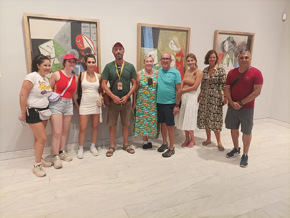
Guided Tour of Picasso Museum with Skip-the-Line Access
Discover the masterpieces of a Spanish Icon in Barcelona
( 3 ) From: $42.55

Montserrat Monastery Tour from Barcelona
Admire Montserrat’s jaw-dropping mountain range, enjoy skip-the-line monastery tickets, and more!
( 5 ) From: $64.40

Skip the Line
Paris Catacombs Tour with Secret Rooms & Privileged Access
Skip the line and gain exclusive access to secret parts of the Catacombs
( 119 ) From: $101.15

Tuscany Day Trip from Rome with Vineyard Lunch and Wine Tasting
Wander through the medieval towns of Montepulciano and Pienza and enjoy a 3-course meal!
( 10 ) From: $132.25

Skip the line
Ultimate Palace of Versailles Tour from Paris
Breeze past the lines for the palace and gardens with a friendly English speaking guide
( 542 ) From: $113.80

Rome in a Day Tour with Colosseum and Vatican Museums
Explore the Sistine Chapel, St. Peter's Basilica, Roman Forum, Pantheon, Trevi Fountain, and more!
( 1877 ) From: $172.45

St. Peter's Dome Climb and Sistine Chapel Combo Tour
Begin your day early and see Rome from above, the Papal Crypts below, and the Vatican museums nearby
( 487 ) From: $120.12

Rome Catacombs Tour and Capuchin Crypts with Transportation
Skip the line and explore a creepy underground world of Roman tombs and crypts with an expert guide
( 386 ) From: $64.35

Semi-Private Vatican Tour with Sistine Chapel
Enjoy a premium and exclusive tour of the Raphael Rooms, St.Peter's Basilica, and more!
( 1234 ) From: $154.62

Exclusive Access
Special Access Colosseum Arena Floor Tour through the Gladiator's Gate
Walk in the footsteps of gladiators on the Colosseum floor and see the Roman Forum and Palatine Hill
( 2040 ) From: $79.35

Vatican at Closing Time with Sistine Chapel
Book a unique experience that visits the Vatican in the early evening with fewer crowds
( 216 ) From: $96.60

Skip the Line Sagrada Familia Tour
Discover the stories and secrets behind Gaudi’s grand basilica with an expert tour guide
( 180 ) From: $62.62

London Walking Tour with Westminster Abbey and Changing of the Guard
Explore royal history at London's famous church before seeing Buckingham Palace's iconic ceremony
( 317 ) From: $91.95

Florence Walking Tour with Statue of David
Uncover the best of Florence at the Duomo and Ponte Vecchio, and skip the line at Accademia
( 525 ) From: $68.95

Privileged Entrance Vatican Tour with Sistine Chapel
Skip the line and gain direct access to the Raphael Rooms, Creation of Man, and St. Peter's Basilica
( 1591 ) as low as $95.68

Guided Tour
Trastevere Local Food Tour in Rome
Join a culinary guide to savor authentic Roman food, such as tasty cheese, pasta, gelato, and wine
( 553 ) From: $106.90

Secrets of the Louvre Museum Tour with Mona Lisa
Get to know Venus de Milo, Liberty Leading the People, and Napoleon's Coronation like never before
( 469 ) From: $86.20

Unbeatable Barcelona in a Day Tour
Discover the real culture of the city at Sagrada Familia, Park Guell, and the Gothic Quarter
( 301 ) From: $143.12

Entry Ticket
Vatican Museums & Sistine Chapel Tickets
Skip the line and gain quicker access to the Vatican so you can explore at your leisure
( 66 ) From: $45.37

Skip the Line Uffizi Gallery Tour
See Botticelli, Caravaggio, and Michelangelo's masterpieces in Florence's famous Uffizi Gallery
( 389 ) From: $74.75
Our Destinations
Experience the world like a local

How we create a unique experience

Find Something People Love
From famous attractions to lesser known hidden gems.
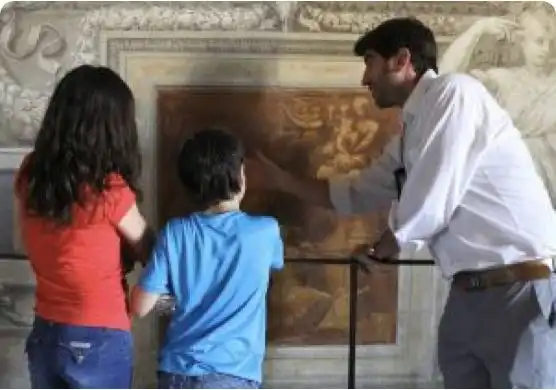
Certified Guides
Handpicked guides who are extremely qualified & passionate about history and storytelling.

Privileged Access
Visit a restricted area, visit at night, before opening. We get you where others can't.
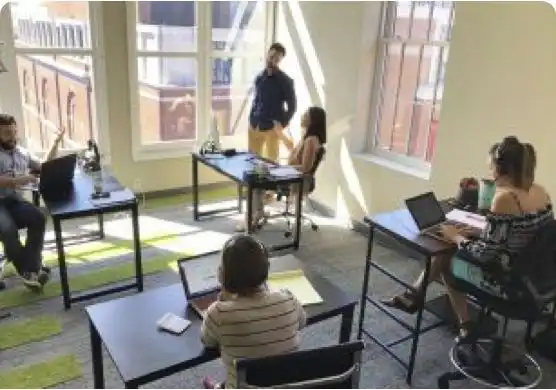
Dedicated Customer Service
Bookings, changes, or even just advice; we are like friends, always there for you.
Europe is re-opening for visitors!
Want to see which small group tours are now operating ?
More tours added weekly!
See Open Tours

- Italy Travel Blog
- In The Press
- Help Center
- Top Attractions
Policy & Terms
- Cancellation Policy
- Terms & Conditions
- Privacy Policy
- USA or Canada: +1 888 290 5595
- Email: [email protected]

© 2024 - The Roman Guy All rights reserved.

London: Buckingham Palace and Royal London Walking Tour
Embarking on a journey through the heart of London’s royal legacy, the Buckingham Palace and Royal London Walking Tour offers travelers a captivating glimpse into the grandeur of the British monarchy . From iconic landmarks like St James’s Palace to the opulent State Rooms of Buckingham Palace, this five-hour experience immerses participants in the rich tapestry of royal traditions and the impending coronation of King Charles III . With insights from knowledgeable guides, visitors can deepen their appreciation for the enduring allure of the British crown and uncover the hidden stories that have shaped the nation’s storied past. Whether a seasoned enthusiast or a curious newcomer, this tour promises to captivate and inspire.
Good To Know
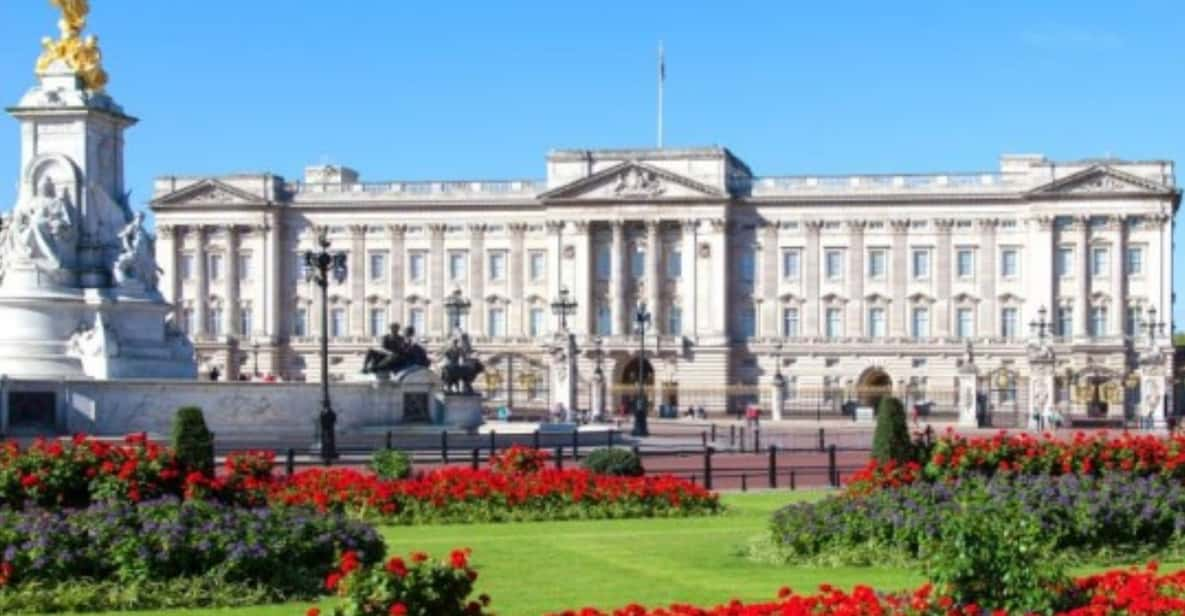
• Guided walking tour focusing on the royal heritage and history of London, including insights into the British monarchy and upcoming coronation.
• Visit Buckingham Palace and explore the 19 State Rooms, Royal Collection, and palace gardens with a multimedia guide.
• Discover royal traditions, such as the changing of the guard, the history of cream tea, and the royal warrant system.
• Tour concludes at Westminster Abbey, providing a comprehensive royal London experience.
• Restrictions include no photography inside the State Rooms and suitability for children over 5 years old.
More tours and experiences nearby.
- Small-Group Tour: Historical Pub Walking Tour of London
- Tour for Muggles
- Jack the Ripper Tour With Ripper-Vision in London
- High-Speed Thames River Speedboat in London
Tour Overview
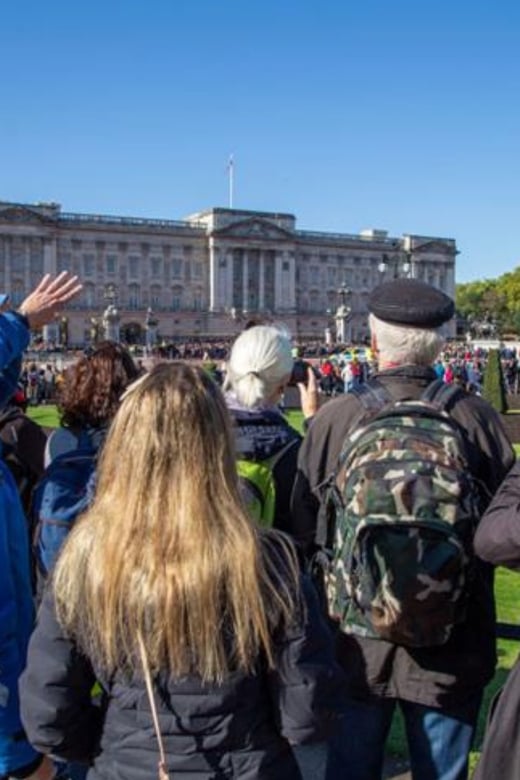
The London: Buckingham Palace and Royal London Walking Tour is a guided excursion that provides visitors with an immersive exploration of the city’s royal heritage, including a visit to the iconic Buckingham Palace.
Priced from CZK 1,292 per person, the tour lasts for 5 hours and is likely to sell out, so it’s best to check for available start times.
Guests will meet at the Tourist Bus Stop outside The Kings Gallery, Buckingham Palace, and the tour will conclude at Westminster Abbey.
Travelers can enjoy a full refund if they cancel up to 24 hours in advance.
The tour’s highlights include insights into the royal family, access to Buckingham Palace, and learning about royal traditions .
Tour Highlights
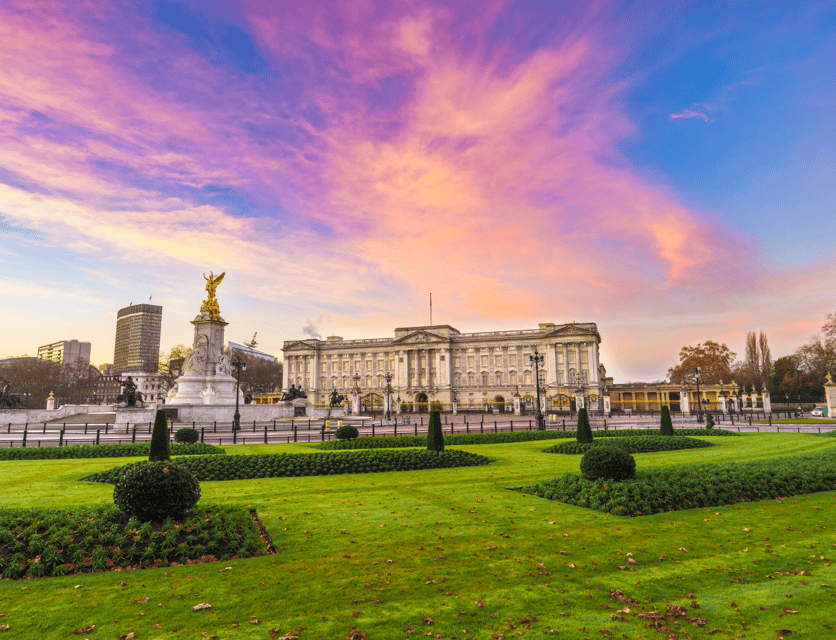
Notably, this guided walking tour focuses on the royal family history and the upcoming coronation of King Charles III, allowing visitors to explore significant sites like St James’s Palace, Horseguards, and the prestigious Royal Warrant holders on Jermyn Street.
The tour also includes entry to Buckingham Palace , where guests can explore the 19 State Rooms, admire the Royal Collection, and see the throne room and gardens.
On top of that, the experience provides insights into royal traditions, from the changing of the guard to the history of cream tea.
With an expert guide leading the way, attendees are sure to gain a deeper appreciation for the pageantry and grandeur of the British monarchy .
Tour Details
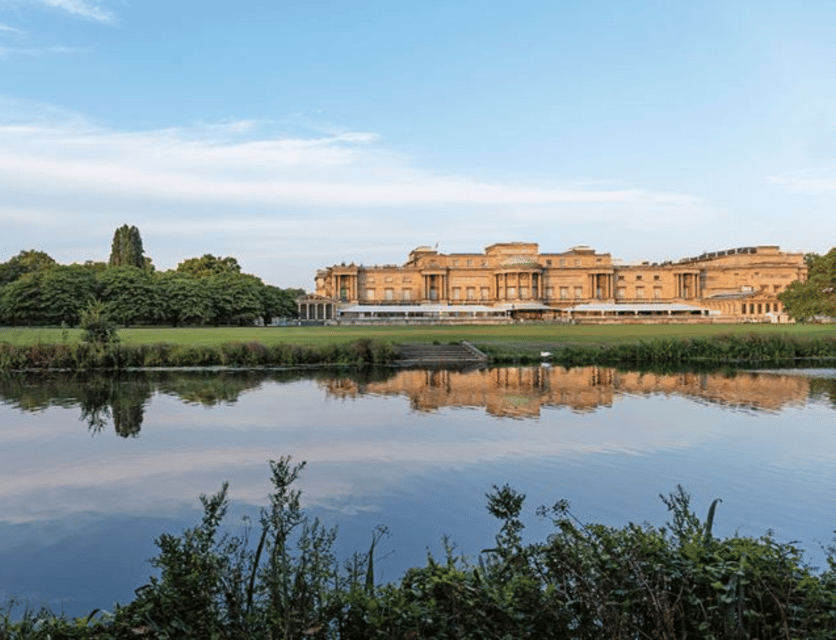
The tour’s itinerary kicks off with a 2-hour guided walking tour, followed by entry to Buckingham Palace at approximately 12:30 PM. During this walking portion, the expert guide provides in-depth insights into the royal family and the historical landmarks along the way.
At the palace, visitors can explore the 19 State Rooms, the Royal Collection, the throne room, and the gardens with the help of a multimedia guide.
The tour offers:
A chance to learn about royal traditions, including the changing of the guard and the history of cream tea.
An opportunity to see the palace’s iconic architecture and opulent interiors.
Insights into the significance of the buildings and their connection to the monarchy.
Information about the palace’s role in the upcoming coronation of King Charles III.
A seamless transition from the walking tour to the palace visit.
Visiting Buckingham Palace
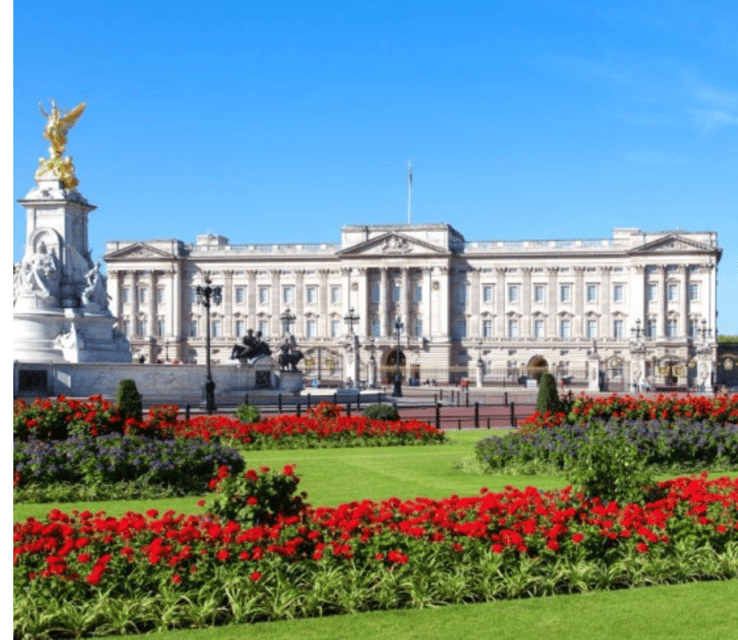
Upon entering Buckingham Palace, visitors are treated to a multimedia guide that enhances their exploration of the 19 State Rooms , the Royal Collection, the throne room, and the palace gardens.
The multimedia guide provides insightful information about the royal family’s history and the significance of the various rooms and artifacts.
As visitors wander through the opulent state rooms, they’ll be captivated by the ornate furnishings, intricate artwork, and grand chandeliers that reflect the palace’s rich heritage.
The tour also allows guests to witness the iconic Changing of the Guard ceremony, a longstanding royal tradition that adds to the overall experience.
With the multimedia guide as a companion, visitors can enjoy the grandeur and traditions of the British monarchy.
Royal Traditions and History
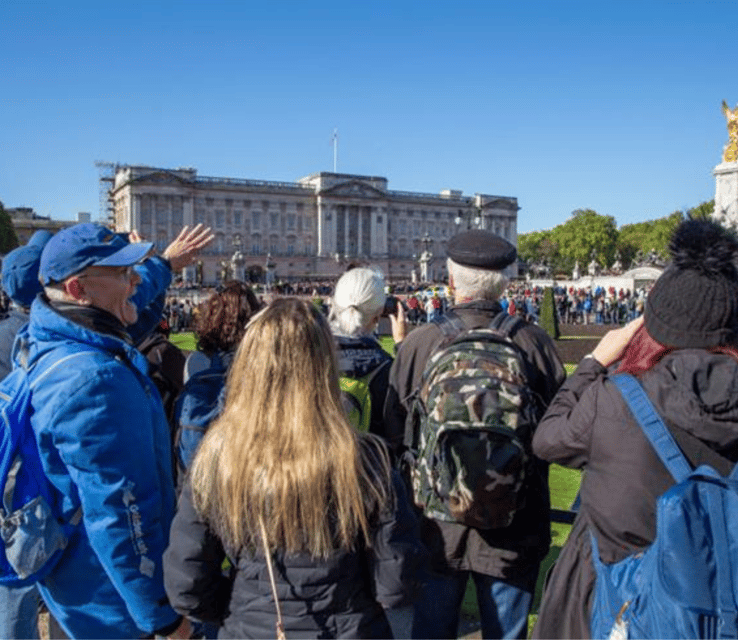
Along With the grandeur of Buckingham Palace, the walking tour provides insights into the rich history and time-honored traditions of the British royal family.
Visitors can learn about the royal lineage, coronation ceremonies, and ceremonial customs that have shaped the monarchy over the centuries.
The tour delves into fascinating aspects of royal life, including:
The history and significance of the changing of the guard ceremony
The tradition of afternoon tea and its association with the royal household
The symbolism and protocol behind the royal warrant system
The evolution of royal fashion and the role of couturiers in the royal wardrobe
The customs and protocols surrounding the coronation of a new monarch
Meeting Point and Return
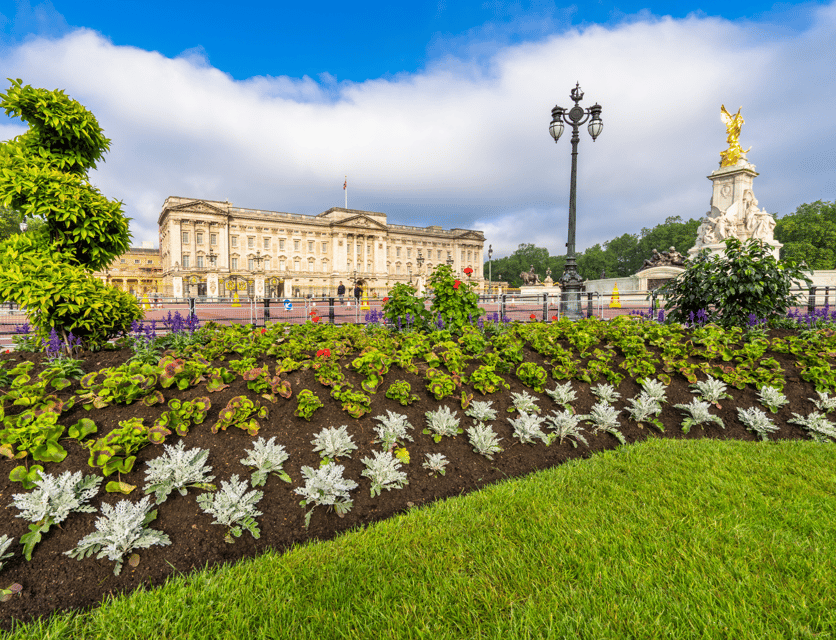
Visitors meet at the Tourist Bus Stop outside The Kings Gallery, Buckingham Palace, where they’ll embark on the comprehensive walking tour of royal London. After exploring the city’s royal landmarks, the tour concludes at the iconic Westminster Abbey. The meeting and return points are strategically chosen to maximize the tour’s efficiency and convenience. Here’s a quick overview:
With a seamless start and end, the tour ensures guests can make the most of their royal London experience.
Tour Restrictions and Policies
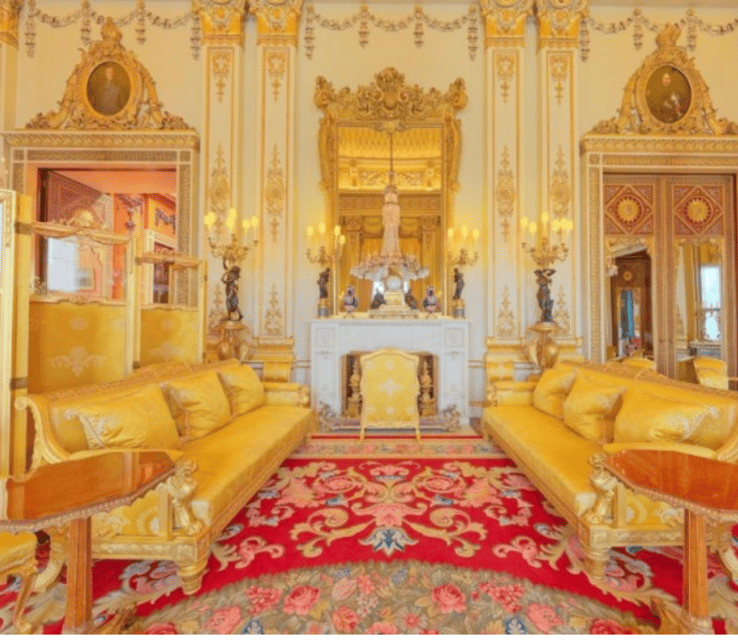
The tour has several important restrictions and policies that guests must be aware of to ensure a seamless and enjoyable experience.
For instance, weapons, food, drinks, and large bags aren’t permitted on the tour. Plus, photography isn’t allowed inside the State Rooms at Buckingham Palace.
Visitors should also note that:
Outdoor areas are the only places where eating and drinking are permitted.
Bicycles and scooters aren’t allowed on the tour.
The tour isn’t suitable for children under 5 years old.
Guests are encouraged to wear comfortable shoes for the walking portion of the tour.
Large bags must be stored elsewhere, as they aren’t permitted on the tour.
Customer Feedback
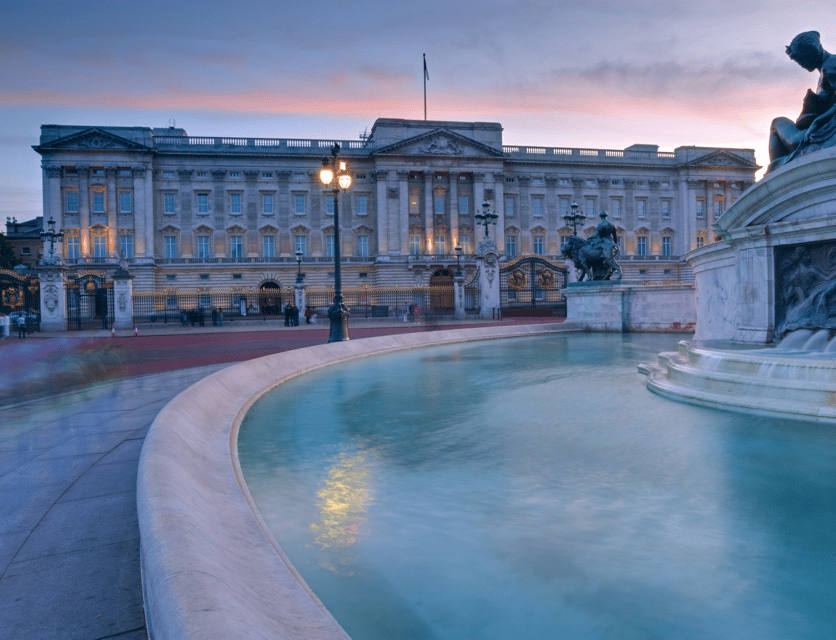
Customers have generally provided a 4/5 overall rating for the Buckingham Palace and Royal London Walking Tour based on 45 reviews, with common feedback highlighting the knowledgeable and engaging guides, but also noting difficulties in locating the meeting point and expressing dissatisfaction with the restrictions on photography inside the State Rooms. The audio guide was praised for enhancing the overall experience, though some customers reported issues with refunds following changes in tour plans. The tour’s strengths lie in its ability to provide insights into royal family history and traditions, including the changing of the guard and cream tea history, while its limitations include the restrictions on certain activities and the logistics of the meeting point.
Here's a few more nearby tours and experiences we think you'll like.
- Windsor Castle, Stonehenge and Bath Tour From London & Admissions
- From London: Paris Day Tour W/Eiffel Tower Champagne Lunch
- From London: Paris Tour With Lunch Cruise & Sightseeing Tour
- From London: Paris Day Tour by Train With Guide and Cruise
- Original Harry Potter Locations Tour – London
- Stonehenge and Bath Tour From London
Frequently Asked Questions
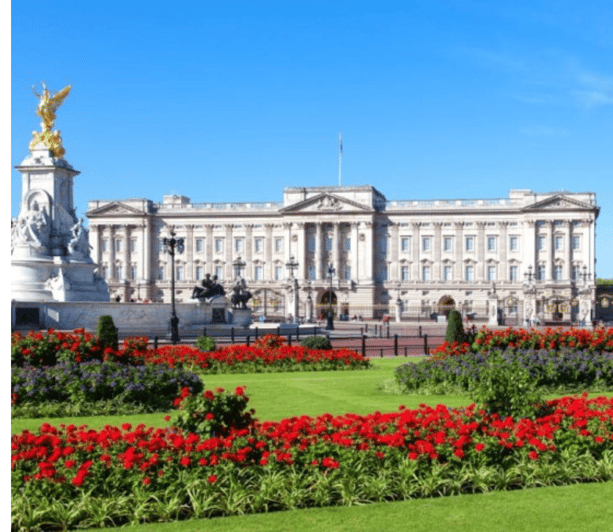
Can I Book This Tour for a Private Group?
Yes, this tour can generally be booked for a private group. Private tours often offer more flexibility in group size, start times, and customization to meet the group’s specific interests. Check with the tour provider about availability and pricing for a private booking.
What Is the Dress Code for Visiting Buckingham Palace?
There is no strict dress code for visiting Buckingham Palace, but visitors are advised to dress respectfully. Casual attire is generally acceptable, though guests should avoid revealing clothing, shorts, or torn/distressed items.
Are Wheelchair or Stroller Rentals Available on the Tour?
According to the tour information, there are no wheelchair or stroller rentals available. However, the tour appears suitable for visitors with mobility aids, as it includes a walking component followed by self-guided exploration at Buckingham Palace.
Can I Purchase Souvenirs During the Tour?
The tour offers opportunities to purchase souvenirs from the Buckingham Palace gift shop during the tour. However, food and drinks are only allowed in outdoor areas, and large bags must be stored elsewhere before the tour begins.
How Accessible Is the Walking Portion of the Tour?
The walking portion of this tour is generally accessible, though some participants may find the pace or terrain challenging. Tour guides are attentive to accessibility needs and can provide alternatives where necessary to ensure all guests can comfortably participate.
Not for you? Here's more of our most recent tour reviews happening neaby
- Private Round-trip Transfer: Heathrow Airport ↔ Colchester.
- Private Round-trip Transfer: From Heathrow Airport ↔ Dorking
- Portsmouth Historic Dockyards and HMS Victory Tour From London
- Gatwick Airport – To & From Central London – Meet & Greet
- Painted Hall – Afternoon Tea, Entry and Standard Tour
- London: Private Couples Photography Session With Landmarks
- Paris Small Group Tour With River Seine Lunch Cruise From London
- London To Brighton Transfers
- Charles Dickens Private Walking Tour
- London: Guided or Self Guided Tour of Windsor & Castle
- Skip-the-line Westminster Abbey London Guided Tour
- Saints & Sinners Walks by Sams Walks
- London: Parliament, Palaces, Parks & Piccadilly Walking Tour
- London to Oxford & Bicester Village Tour Return
- Transfer To/ From Southampton Cruise Port to Central London
The London: Buckingham Palace and Royal London Walking Tour offers a captivating exploration of the British monarchy.
Guests can enjoy the opulence of 19 State Rooms at Buckingham Palace, learn about royal traditions , and gain insights into the upcoming coronation of King Charles III .
This 5-hour experience provides an unparalleled opportunity to appreciate the rich heritage of the British royal family.
Similar Posts

Ibiza Wooden Sail Boat Trip to Formentera

Titanic Belfast Entrance Ticket: Titanic Visitor Experience Including SS Nomadic

Schwarzwasserbach: Canyoning in Austria’s Kleiwalsertal

Lighthouse Park Hike

Mykonos Cruise Ship Transfer

Scuba Diving in Side
Protect Your Trip »
20 top things to do in hershey, pennsylvania.
There's more to Hershey than chocolate (though the chocolate is well worth a visit).

Top Things to Do in Hershey, PA

Courtesy of Hershey Entertainment & Resorts
Did you know Milton Hershey founded a successful caramel company (the Lancaster Caramel Company) before he ever mastered the art of chocolate making? That's just one of the many morsels of history you'll discover on a trip to Hershey, Pennsylvania, otherwise known as the "Sweetest Place on Earth."
You'll also learn that Hershey used his wealth to build the town everyone knows today, with schools such as the Milton Hershey School for underprivileged children, The Hotel Hershey and Hersheypark – today considered one of the best amusement parks in the U.S. Nearly 80 years after Hershey's passing in 1945, the town he built continues to blossom, with something new (and delicious) to explore each year. Read on to discover the best things to do in Hershey right now.
Hershey's Chocolate World
You haven't truly experienced Hershey until you've taken the free Hershey's Chocolate Tour. The tour – an indoor ride in a Hershey's Kiss-shaped car – gives visitors a behind-the-scenes look at how Hershey's chocolate is made. The tour concludes with free chocolate for all visitors – the highlight of the whole experience.
Better still is the marketplace at Hershey's Chocolate World, where you can purchase Hershey's candy (including treats you may not find back home); candy-themed souvenirs; and signature milkshakes, ice cream and pastries. You can also make a personalized treat at the Create Your Own Candy Bar station, embark on Hershey's Great Candy Expedition (an immersive movie experience), and enjoy wine and chocolate pairings seasonally.
Address: 101 Chocolate World Way, Hershey, PA 17033
Hersheypark

Hersheypark features more than a dozen roller coasters – including Laff Trakk, the first indoor spinning glow coaster in the U.S. The amusement park also features an outdoor water park and kiddie rides, plus rides and attractions the whole family can enjoy together. When it's time for a break, order one of the park's famous King Size Shakes, available at Simply Chocolate. The one-of-a-kind amusement park is especially magical at Christmas, when the park hosts Hershey Sweet Lights, an illuminated drive-through tour across 2 miles, and Christmas Candylane, where guests can sip hot cocoa and meet Santa and his reindeer.
Address: 100 W. Hersheypark Drive, Hershey, PA 17033
The Spa at The Hotel Hershey

Melt into The Spa at The Hotel Hershey (also known as The Chocolate Spa), where treatments include a cocoa massage and a chocolate fondue wrap. You don't have to get a chocolate treatment, though – there are plenty of other options, from the Lomi-Lomi Four-Handed Massage to teen-specific services. An on-site salon where you can get your hair, makeup and nails done is also available.
Before or after your treatment, take time to enjoy the spa facilities, which include an indoor pool, a hot tub, a steam room, a sauna, and The Oasis lounge and restaurant, where you can have lunch (reservations required) and cocktails. You don't have to be a guest of the hotel to take advantage of the spa, though a stay at the property is highly recommended.
Address: 100 Hotel Road, Hershey, PA 17033
MeltSpa by Hershey

Another spa option, MeltSpa by Hershey offers chocolate-infused (and non-chocolate-infused) massages, facials, manicures and the like, plus treatments designed for teens, men and expectant mothers. Located on Chocolate Avenue in downtown Hershey, this day spa also offers a full-service salon. Previous patrons consistently default to the most important word in any spa review: relaxing.
Address: 11 E. Chocolate Ave., Hershey, PA 17033
Tröegs Independent Brewing

Courtesy of Tröegs Independent Brewing
Known for its award-winning beers including The Mad Elf, a beloved holiday ale, Tröegs Independent Brewing is headquartered in Hershey. Guided brewery tours are available for an in-depth look behind the scenes. Just as good as the beer is the food, which includes everything from an Oktoberfest-style pretzel to seafood pasta. Be sure to try a Scratch Series beer – one of the brewery's latest experiments – when you visit, and don't miss the merchandise store, where you can buy everything from four-packs to Tröegs beer-infused soap.
Address: 200 Hersheypark Drive, Hershey, PA 17033
Hershey Trolley Works

Courtesy of Hershey Trolley Works
Go for a ride with Hershey Trolley Works, which offers narrated excursions around town. Themed tours include the 75-minute Historical Trolley Tour that's offered year-round; the Original Trolley Show, which is a 45-minute family-friendly show that brings the story of Milton Hershey to life (summers only); and festive Halloween and Christmas trolley tours. The friendly tour guides get rave reviews, and previous patrons say they learned things about the area that they wouldn't have otherwise discovered.
AACA Museum, Inc.
The AACA Museum, also known as America's Transportation Experience, is a Smithsonian affiliate. It features permanent exhibits such as the Hershey's Kissmobile Cruiser, as well as rotating installments that have included everything from unrestored classic cars to vintage go-karts. The museum is open year-round (and makes the perfect rainy day activity in the summer). It continually earns numerous positive reviews from visitors, and many people say you don't have to be into cars to enjoy the museum.
Address: 161 Museum Drive, Hershey, PA 17033
Tips on Trips and Expert Picks Newsletter
Travel tips, vacation ideas and more to make your next vacation stellar.
Sign up to receive the latest updates from U.S News & World Report and our trusted partners and sponsors. By clicking submit, you are agreeing to our Terms and Conditions & Privacy Policy .
Hersheypark Stadium

Jesse Faatz | Courtesy of Hershey Entertainment & Resorts
If you're planning a summertime visit to Hershey, be sure to check the schedule at Hersheypark Stadium, where big-name concerts are typically hosted from June through September. The outdoor venue offers food and beverage concessions and – the ultimate splurge – VIP Boxes. Hersheypark Stadium hosts everyone from Green Day to Post Malone.
Address: 100 Hersheypark Drive, Hershey, PA 17033
Giant Center

If you're looking for indoor entertainment in Hershey, see what's on the schedule at the Giant Center. Here you can see a Hershey Bears hockey game, a WWE SmackDown show, a concert or a comedy show. Traveling tours such as Disney on Ice also have residencies at the Giant Center.
There's really no such thing as a bad seat at the Giant Center, as many reviewers comment that the views are good no matter where you sit (but that seats could use an update). The Giant Center is open year-round.
Address: 550 Hersheypark Drive, Hershey, PA 17033

One of the first attractions to open in Hershey, ZooAmerica was established in 1910 as the Hershey Zoo. More than a century later, the zoo has expanded to house a couple hundred animals across a variety of species and to support several wildlife and environmental conservation efforts. For an extra-special experience, book an after-hours tour of the zoo. ZooAmerica is located within Hersheypark, and admission to the zoo is included in your park pass.
Address: 201 Park Ave., Hershey, PA 17033
Founders Hall at the Milton Hershey School

Courtesy of Milton Hershey School
Founders Hall honors Milton Hershey and his wife, Catherine, for their commitment to helping children in need. The Visitors Center with its gorgeous marble interior dome is worth a visit on its own, as are the grounds of the property. This Hershey landmark also features a 2,400-seat auditorium for concerts and symphony orchestras. Previous visitors say Founders Hall is a must-visit in Hershey, noting how amazed they were by the history of the Milton Hershey School.
Address: 1201 Homestead Lane, Hershey, PA 17033
The Hershey Story Museum

Courtesy of The Hershey Story Museum
Of course, there's no better place to learn about Hershey than The Hershey Story Museum. Exhibits include Failures to Fortune, which tells the story of Milton Hershey's childhood, apprenticeships and business ventures; Sweet Innovations, where you can see some of the equipment used in the original chocolate factory; and the Power of Promotion, which shows how Hershey came to be the beloved candy brand it is today. The Hershey Story Museum also offers a hands-on Chocolate Lab and seasonal chocolate tastings. Reviewers rave about their experiences here, noting that you could spend hours at the museum and still not cover everything.
Address: 63 W. Chocolate Ave., Hershey, PA 17033
Hershey Gardens

Courtesy of Hershey Gardens
Stop and smell the roses at Hershey Gardens – that's exactly what Milton Hershey intended for visitors when he requested to "create a nice garden of roses" in his town. Aside from fragrant flowers featured in seasonal and themed displays, Hershey Gardens offers a whimsical children's garden with interactive play structures and a butterfly atrium where you can get up close with butterflies – so close they might land right on your head or hands. Guided walks and gardening classes are also available. Travelers say the gardens are not only beautiful, but also relaxing.
Address: 170 Hotel Road, Hershey, PA 17033
The Falconry Experience
Did you know you could interact with falcons in Hershey? Offered at The Hotel Hershey and available to both guests and the general public, The Falconry Experience features free-flight and simulated hunt demonstrations, and the chance to have birds of prey land right on your hand. Private group and family sessions are available too, and kids ages 12 and younger must be accompanied by an adult. Past visitors say this is one of the most unique experiences they've ever had.
Hershey Theatre

Visitors to Hershey should try to catch a show at the Hershey Theatre located downtown. The performing arts center offers concerts, comedy acts, touring Broadway shows and more. You can also take the Hershey Theatre Spotlight Tour, which provides a behind-the-scenes look at the historic theater that opened in 1933. Plenty of parking and concessions are available. Previous patrons appreciate that they could enjoy Broadway-caliber shows in Hershey.
Address: 15 E. Caracas Ave., Hershey, PA 17033
Echo Dell Indian Echo Caverns
Explore underground caves at Echo Dell Indian Echo Caverns in Hummelstown (Derry Township), just outside of Hershey. Guided 45-minute tours allow visitors to explore the stunning natural formations and how they came to be. Outside of the caves, kids can mine for mineral stones at Gem Mill Junction, climb on the playground and visit animals at Discovery Barnyard. Recent visitors recommend bringing a light jacket and water shoes (or shoes with good traction that can get wet).
Address: 368 Middletown Road, Hummelstown, PA 17036
Swatara Creek

Getty Images
You might not associate outdoor adventures with a town that revolves around chocolate, but you can go fishing, tubing and kayaking on Swatara Creek, which has several entry points near downtown Hershey. For gear rentals and guided tours, check out Cocoa Kayak Rentals and Susquehanna Outfitters. Travelers say both companies are great and offer all necessary gear, including life jackets.
Crossroads Antique Mall
If you enjoy all things vintage and collectibles, plan a stop at Crossroads Antique Mall in Hershey. Housed in an old barn, the mall offers antique pieces from a variety of vendors – including unique Hershey items from the past. Reviewers have had great experiences at the antique mall but warn some vendors can be aggressive.
Address: 825 Cocoa Ave., Hershey, PA 17033
Pennsylvania State Police Museum

Courtesy of Pennsylvania State Police Museum
Exhibits at the Pennsylvania State Police Museum include restored patrol vehicles, crime scene forensics, vintage uniforms and more. Both guided and self-guided tours are available, though guided tours must be booked two weeks in advance. Past visitors love the gift shop and recommend also scheduling a tour of the adjacent Pennsylvania State Police Academy.
Address: 187 E. Hersheypark Drive, Hershey, PA 17033
When planning your trip to Hershey, be sure to make reservations at The Mill, where farm-to-table fare is served in a beautifully rustic setting. Everything is delicious, but the weekend brunch menu – with options including chicken and waffles and blue crab benedict – is arguably the best. Recent travelers love the atmosphere as much as they love the food, with many saying it's their favorite restaurant in the area.
Address: 810 Old West Chocolate Ave., Hershey, PA 17033
Why Trust U.S. News Travel
Amanda Norcross , a resident of Pennsylvania, has been visiting Hershey since she was a kid. Along with her personal experiences, she consulted recent attraction reviews to craft a list of the sweetest places to visit in Hershey. Her personal favorites are The Spa at The Hotel Hershey and Tröegs.
You might also be interested in:
- The Best Hotels in Hershey
- The Top Things to Do in Lancaster, Pennsylvania
- The Top Things to Do in Pennsylvania, According to a Local
- The Best Places to Visit in Pennsylvania
Tags: Travel , Pennsylvania Vacations , Mid-Atlantic Vacations
World's Best Places To Visit
- # 1 South Island, New Zealand
- # 4 Bora Bora
If you make a purchase from our site, we may earn a commission. This does not affect the quality or independence of our editorial content.
You May Also Like
The best college town hotels.
Rachael Hood Aug. 29, 2024

Fun Fall Weekend Getaways
Aug. 29, 2024

Best Hoover Dam Tours from Las Vegas
Holly Johnson and Ann Henson Aug. 29, 2024

The Best London Tours
Kim Foley MacKinnon Aug. 29, 2024

The 18 Best Barcelona Tours
John Rodwan Aug. 28, 2024

Best Fall Family Vacations
Aug. 27, 2024

The Top Fall Festivals in the U.S.
Katie Hearsum and Timothy J. Forster Aug. 27, 2024

Top Music-Themed Cruises
Gwen Pratesi Aug. 23, 2024

The Best Rome Tours
Kyle McCarthy and Ann Henson Aug. 23, 2024

The Best Kids Sail Free Cruises
Holly Johnson Aug. 21, 2024

NEWS... BUT NOT AS YOU KNOW IT
Is this new major Hollywood trend Jenna Ortega kick-started tacky or genius?

Share this with

Jenna Ortega is the most recent queen of the art of ‘method dressing,’ and the internet can’t stop talking about it – and speculating whether the trend has finally gone too far.
For the uninitiated, ‘method dressing’ is when an actor wears clothes inspired by the film they’re promoting or even the specific character they play in that film.
Showing up to red carpets and public appearances in outfits that walk the line between fashion and costume, the Beetlejuice, Beetlejuice, Beetlejuice! star has helped cement themed dressing as a modern fixture of movie promotion.
Other stars to embrace the phenomenon include Margot Robbie , who perpetually wore pink before Barbie came out; Wicked co-stars Ariana Grande and Cynthia Erivo , who have been wearing the color palettes of their respective characters, Glinda and Elphaba, for weeks; and Halle Bailey , who wore Little Mermaid inspired fashion to promote the live-action remake.
But Ortega was among the first to take the trend to the next level, dressing consistently like Wednesday Adams ahead of the hit Netflix show Wednesday in 2022.

Ortega’s stylist Enrique Melendez has helped orchestrate several spooky fashion moments for the actress – including a pinstriped Dolce & Gabbana skirt suit that paid subtle homage to the OG film – in the lead-up to the Tim Burton Beetlejuice sequel, out September 6.
But another of Ortega’s Beetlejuice fashion moments has sparked a conversation about when method dressing crosses the line from fun and entertaining to gimmicky.
On one occasion, the actress wore a look inspired by Winona Ryder’s character Lydia Deetz in the original 1988 film.
In a plaid schoolgirl skirt and navy blue cardigan with a golden wreath crest, she essentially wore the costume Ryder wore in the film’s closing scene’s Jump in the Line dance number.

If this wasn’t on the nose enough, the outfit was paired with a purse that read, ‘Handbag for the Recently Deceased’ a play on a book in the film called Handbook for the Recently Deceased that the film’s parent characters, Adam and Barbara Maitland (played by Alec Baldwin and Geena Davis), receive once they die.
The effect of the look was to turn Ortega into a walking ad, completely sublimating any sense of personal style and blurring the line between the world of the film and the real world.
One Reddit user, Special-Garlic1203, put it succinctly, writing: ‘At that point it’s not even method dressing anymore, it’s just a glorified Halloween costume.’

Blue_orchid2 agreed, posting: ‘Copying or heavily referencing a character’s outfits for press runs is getting stale. It’s not very creatively inspiring. Feels like a cop out if I’m being honest, even when said outfits are cute. They used to be much more subtle about it when they did it but since the Barbie press tour, we’ve just been getting variations of this.’
Nope_pls wrote: ‘Cannot wait for method dressing to die already.’
Another user also weighed in, positing that while they enjoy the trend it sometimes feels forced: ‘I love method dressing but not when it’s too on the nose. Like I hated that one tennis ball look Zendaya wore as well. But when it’s “subtle” I guess, I think it’s hard to beat. I think setting it as an expectation can get exhausting though. Like do it when you can be clever and then just wear something generically cute when it seems forced.’
Zendaya has also been a victim of method dressing gone too far.

The actress and her stylist, Law Roach, have been major purveyors of the trend, claiming headlines for weeks as the young star appeared in intergalactic fashion in the lead-up to Dune 2 .
Between the Theirry Mugler gynoid suit and the 1999 Givenchy by Alexander McQueen that she wore to promote the film, the actress successfully stayed true to her impeccable style while amping up anticipation for the sci-fi blockbuster.
But her press appearance looks for Challengers, in which she plays professional tennis star Tashi Donaldson, were less of a grand slam.
At one point wearing shoes that featured literal tennis balls, the Euphoria star tipped into gimmicky, seeming more like a person in perpetual costume than a fashion icon.
Zendaya’s two most recent press tours highlight that method dressing is not a one-size-fits-all strategy, and many movies are better off without it.

Movies with distinct, over-the-top aesthetics, like Dune or Barbie, are perfect for this style of marketing, but applying the trend to more serious movies grounded in realism feels forced and tacky.
This was exemplified by Blake Lively wearing (and trying to get fans to wear) florals in the lead-up to It Ends With Us , a film about a woman who experiences domestic violence and happens to be a florist.
Method dressing also uncomfortably emphasises the disparity in Hollywood’s expectations of men vs. women, with very few male actors participating in the trend with any level of commitment.

Anya Taylor-Joy and Chris Hemsworth were recently pulled through Los Angeles in a horse and carriage to promote Mad Max: Furiosa , with the actress wearing a black leather dress and dramatic makeup, looking for all the world like a post-apocalyptic road warrior.
In contrast, Hemsworth wore a button-up, blazer, and dark jeans.
The trend also runs the risk of causing actresses to become conflated with their characters, which can easily pigeon hole them and limit their future opportunities.
So, while we’ve enjoyed watching Ortega walk red carpets in black and white stripes, maybe it’s time for actors to return to dressing like themselves.
Got a story?
If you’ve got a celebrity story, video or pictures get in touch with the Metro.co.uk entertainment team by emailing us [email protected], calling 020 3615 2145 or by visiting our Submit Stuff page – we’d love to hear from you.
MORE : We waited 36 years for this unhinged sequel — and it’s 2024’s weirdest film
MORE : Tim Burton reveals how he found himself again after getting ‘lost along the way’
MORE : You can buy a real-life Barbie phone now, but it’s a brick costing £99

Get us in your feed

IMAGES
VIDEO
COMMENTS
The City of London organizes tours of the remnants of a Roman bath and house located in the basement of an office building. The tours take place on Saturdays and Sundays, last 45 minutes and cost just £9/adult and £7/concession. Book the tours on their website. 8. Tower Hill Roman Wall.
This private walking tour is an essential experience for anyone passionate about history, archaeology, or the enduring legacy of one of the world's greatest cities. Come along and let us reveal the wonders of Roman London, a journey through time where the past is always underfoot, waiting to be rediscovered.
Plenty! Join our Roman guided tour and let us 'roam' around the City and discover a history that dates back nearly 2,000 years. Let one of our qualified City of London Guides reveal the ancient city of Londinium that lies beneath your feet. Learn why the Romans founded the City of Londinium, what they bought - and what they liked to export.
"Fab tour of Roman London, Ian was a great guide, very knowledgeable and happy to answer questions. I definitely recommend it." Maria "5 stars This was my perfect walking tour. The group was the right size, I could hear everything the guide had to say. There was some walking (much preferable to ambling very short distances).
Last Updated 15 March 2022. A series on some of London's best walking tours. This time, we speak to Hazel Beale, Claudia Colia, Guy Fairbank, Kim Lovell, Ian McDowell, Muhsin Mustafa and Judy ...
The Barbican Roman fort. WHERE: Tour begins from in front of St. Botolph Without Aldgate Church ( map) The church is adjacent to Aldgate Underground Station. The tour ends near St. Paul's Cathedral. Duration: Approximately 2.5 hours. When: Wednesdays and Sundays at 14:00.
About the Roman London Walking Tour. According to mythology the earth was surrounded by a mighty sea called Oceanus; by extending the influence of Rome to the equivalent of outer space the Emperor Claudius was going against accepted wisdom. Britain was worthless and scary at the same time - an island of dangerous people far from the civilised ...
Tailor-made for archaeology fans, this private walking tour takes you off the tourist track and into the nooks and crannies of central London where Roman ruins still lurk, almost 2,000 years after they were built. Discover the old Roman baths, the ancient city walls, the remains of an amphitheater, and, when access allows, the Temple of Mithras that rests beneath a 21st-century office tower.
Roman London Walking Tour 5 / 5 1 Review Activity provider: Ye Olde England Tours View all 9 images Add to wishlist Private tour Roman London Walking Tour Activity provider: Ye Olde England Tours 5.0 1 Review From US$ 217.76 per person. Book now Eco-certified. This activity, attraction, or activity provider has been certified eco-friendly by a ...
Tailor-made for archaeology fans, this private walking tour takes you off the tourist track and into the nooks and crannies of central London where Roman ruins still lurk, almost 2,000 years after they were built. Discover the old Roman baths, the ancient city walls, the remains of an amphitheater, and, when access allows, the Temple of Mithras that rests beneath a 21st-century office tower.
The Roman London Walking Tour continues its exploration of Roman artifacts by uncovering the London Stone and Mithraeum, providing further insights into the ancient history of the city. As participants delve deeper into the tour, they unearth ancient artifacts that offer a deep dive into the history of London. One of the highlights of the tour ...
But this walks aims to dig a little deeper and explore why the Romans came, why they founded London and how it developed through the c.400 years of Roman rule. NB if the dates below don't suit you, email me ([email protected]) to let me know what you want to do: most times I can rearrange the schedule to suit demand. Duration 120 mins (2 ...
The London's Roman Amphitheatre is an interactive and educational attraction, which allows you to dive into the ancient history of Roman London. Please note that on Monday 16 September Guildhall Art Gallery and London's Roman Amphitheatre will be open from 2 to 5pm due to a private event. Lost for centuries, the original circular walls of the ...
March 21, 2021 9 mins. A walking tour through the remaining traces of Roman London. This walk is a companion to the earlier tour of Londinium's Roman walls. Roman sites are few and far between today, but nonetheless anchor us to history and the city's origins. We have two guides on our walk today.
The Museum of London is one of our favourite free museums - a special place that houses thousands of different artefacts from cultures around the world, but there is a piece of Roman history surrounding it.. Take a walk around the outside of the museum, and you will find the remnants of a 5km-long piece of wall that the Romans built to encircle Londinium - imaginatively called London Wall.
Inclusions. Included in the Roman London Self-Guided Walking Tour are lifetime access to the tour in English, the VoiceMap app for Android and iOS, offline access to audio, maps, and geodata, tickets or entrance fees to attractions en route, as well as a smartphone and headphones. With these inclusions, explorers can explore historical discoveries and gain insightful exploration insights ...
Tower of London - There is an old portion of a tower from the London Wall on the grounds of the Tower of London. Tower Hill Tube Station - At the east end of one platform, you can see a very small portion of the subterranean Wall, plus a plaque briefly explaining Roman London. One America Square - Now a commercial building, there are ...
Londinium: Explore The Remains Of Roman London. Distance: Approx 4¼ miles Time required: 1½ to 2¼ hours (based on a leisurely 20-30 mins per mile, but you should add on more time if you want to stop at any of the places) Starting point: Outside Tower Hill station End point: Museum of London What you will see: Roman wall, Tower of London ...
Start: The Tower of London and Medieval Postern Gate. When William the Conqueror built the Tower of London in 1077 he incorporated a section of Roman wall into it. This was unfortunately lost during medieval upgrades to the Tower. You can still see the line of the old wall however inside the Tower, should you visit.
In the 1980s, the Museum of London put together a self-guided walking route along the remaining viewpoints of the Roman London Wall. There were originally 21 plaques along a 2.8km (1.75mi) route; today there are only 11 plaques - and the route I walked clocked in at 3.5km (2.2mi).
Tailor-made for archaeology fans, this private walking tour takes you off the tourist track and into the nooks and crannies of central London where Roman ruins still lurk, almost 2,000 years after they were built. Discover the old Roman baths, the ancient city walls, the remains of an amphitheater, and, when access allows, the Temple of Mithras that rests beneath a 21st-century office tower.
Roaming Roman Ruins in England London. One of the best places to view Romano-British ruins in England is in London itself! The City of London was once an important port of the Roman Empire. Around 200 AD, they built an extensive 2.5-mile-long wall. It was built with fortifications around it to protect this important city, then known as Londinium.
Join our guided tour of ancient Rome, where you'll delve into the history of this amphitheater with an entertaining guide who shares stories of thrilling gladiator battles. Afterwards, explore the Palatine Hill to discover the origins of Rome before concluding your journey at the Roman Forum to witness its ancient ruins. For a more immersive ...
London in a Day Tour with Westminster Abbey and Tower of London. Explore Buckingham Palace, see the Crown Jewels, take a river cruise on the Thames, and more! (283) ... Private Colosseum Tour with Roman Forum, and Palatine Hill. See the Colosseum and ancient Rome like a VIP, the Temple of Caesar, and more! (213)
From London to Rome. 4 Client Reviews. View 2 Answers To Client Questions Ask A Question . Navigation: ... Join an Orientation tour to get to know the city's best beer spots and historical hotspots then you're free to explore the UNESCO World Heritage-listed centre in your own time. A Jewish Quarter, a jaw-dropping castle & museums aplenty are ...
Tour Overview. The London: Buckingham Palace and Royal London Walking Tour is a guided excursion that provides visitors with an immersive exploration of the city's royal heritage, including a visit to the iconic Buckingham Palace. Priced from CZK 1,292 per person, the tour lasts for 5 hours and is likely to sell out, so it's best to check for available start times.
Venta Icenorum had running water, baths, a town hall and a forum, and was enclosed inside walls in the 3rd Century Further digs are to be carried out on a Roman site in the grounds of a hotel ...
The Best London Tours. ... These top-rated Rome tours are led by experts who bring the city's history to life. Kyle McCarthy and Ann Henson Aug. 23, 2024. The Best Kids Sail Free Cruises.
Jenna Ortega is the latest star to 'method dress' to promote a film (Picture: Getty Images) Jenna Ortega is the most recent queen of the art of 'method dressing,' and the internet can't ...